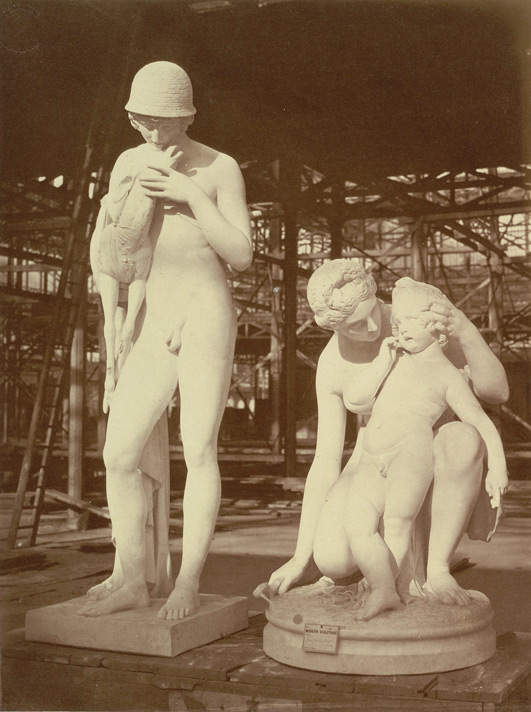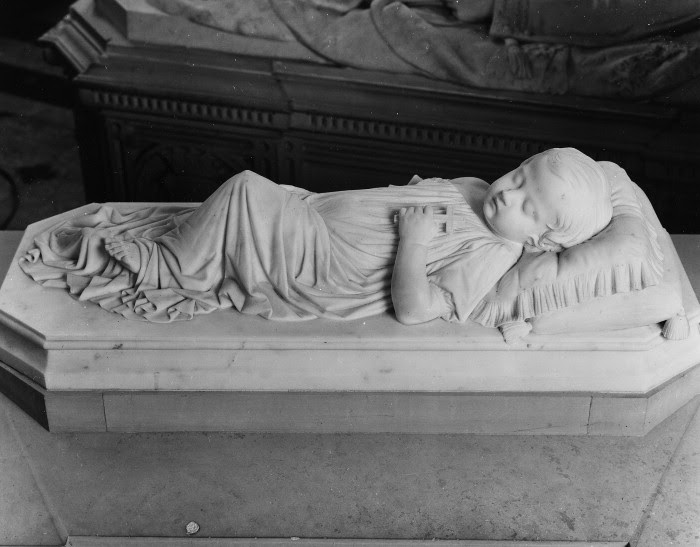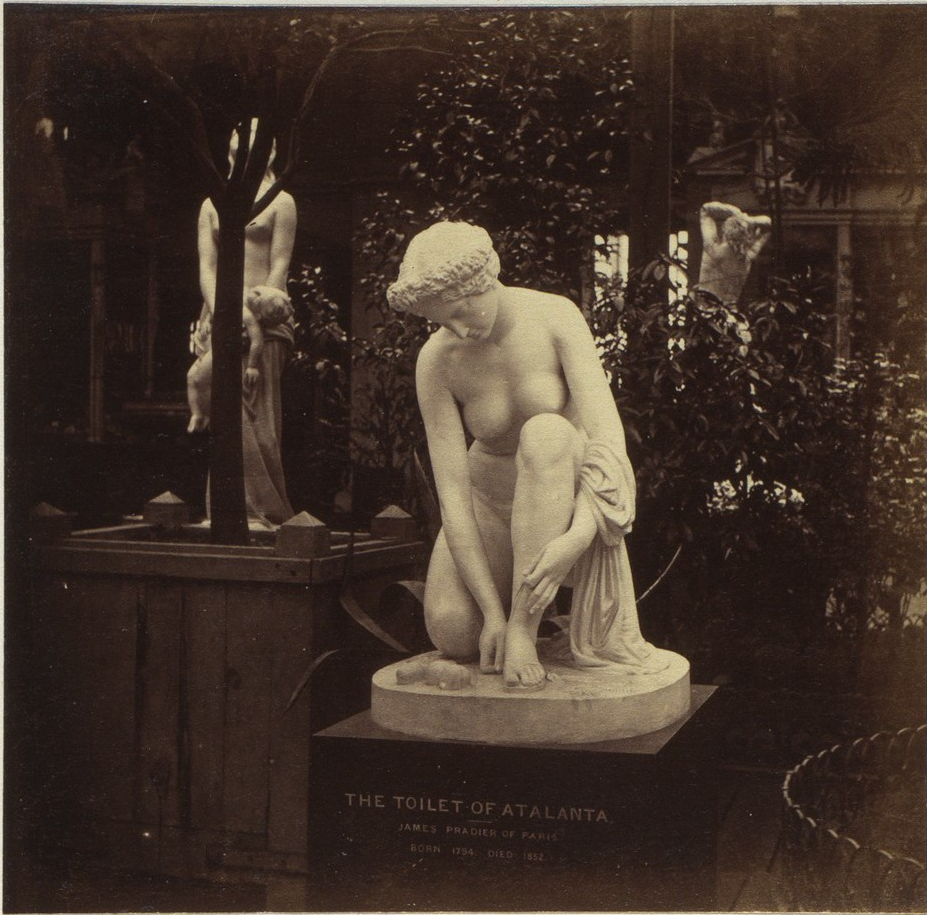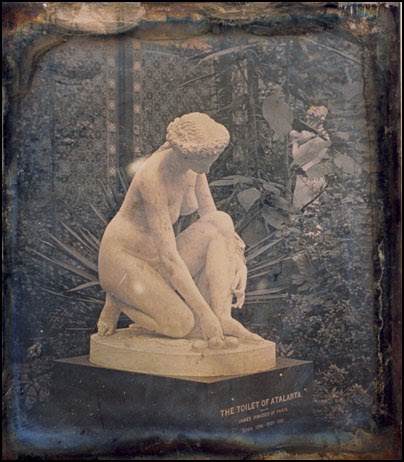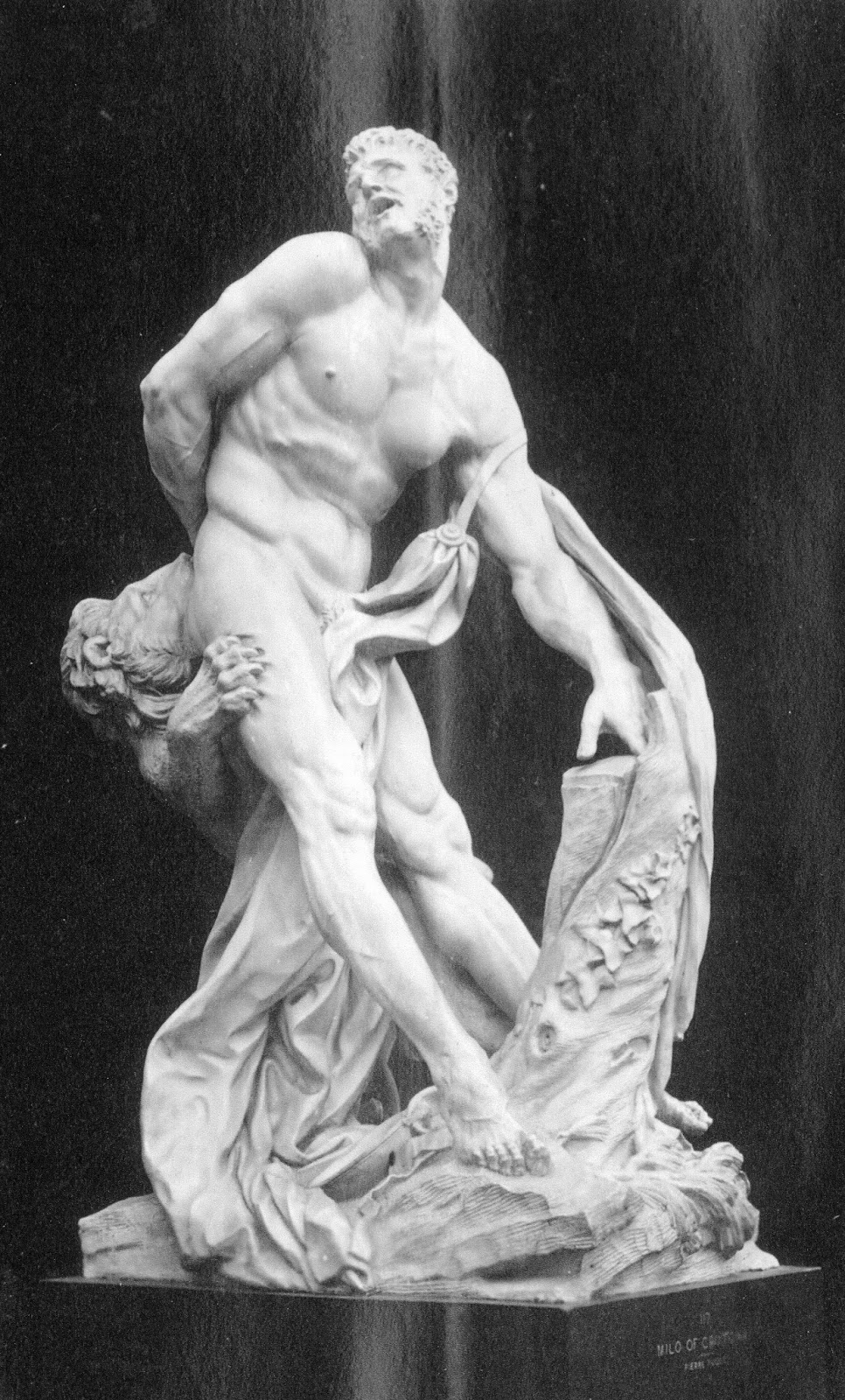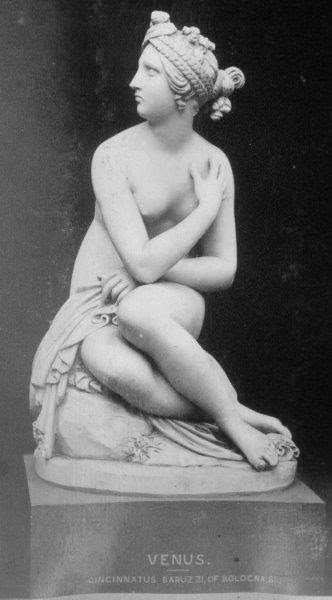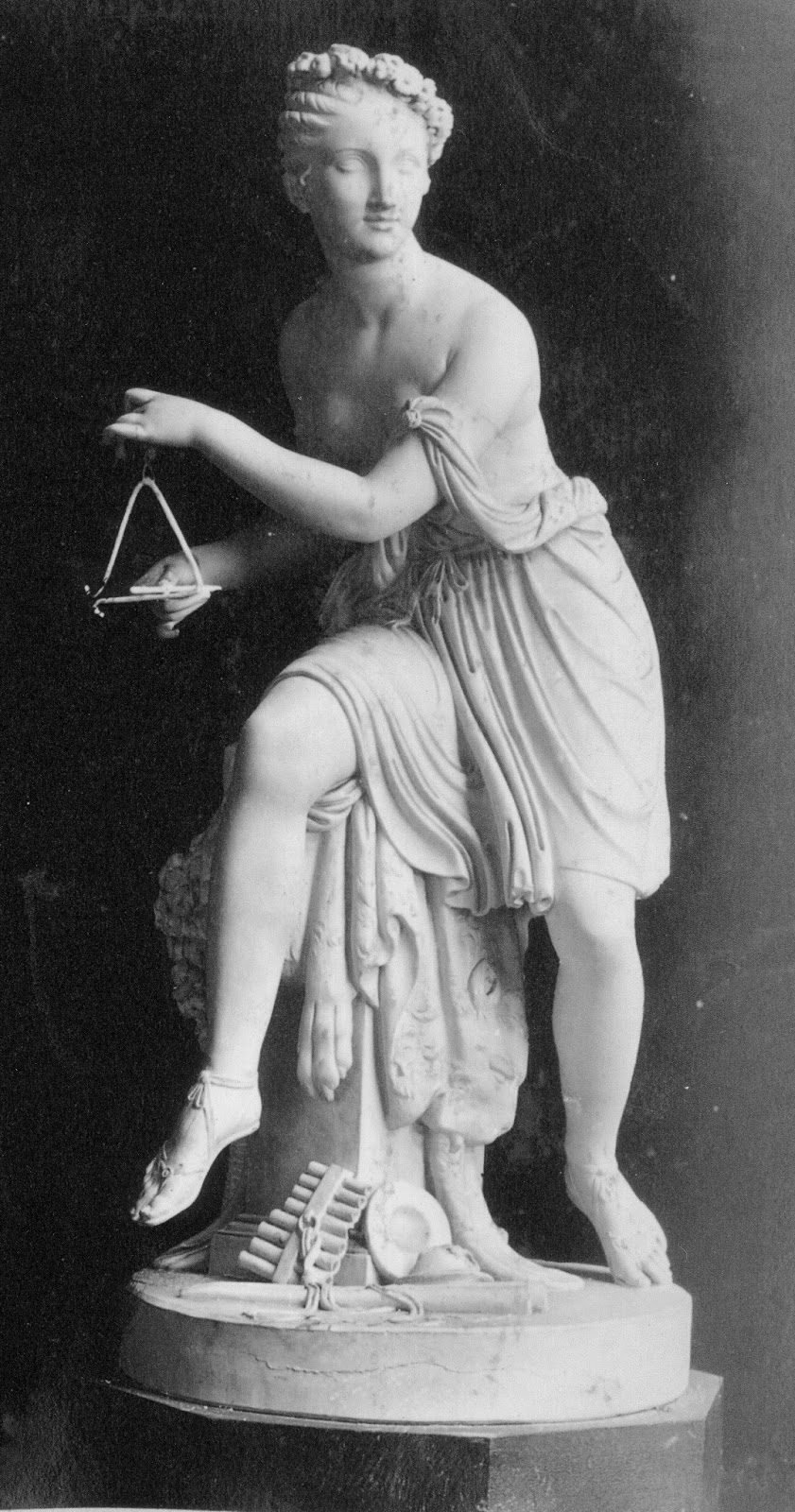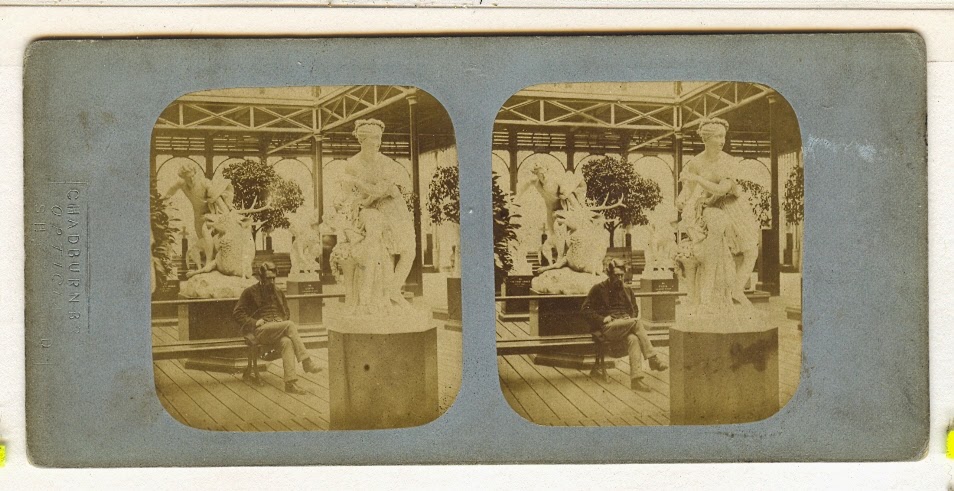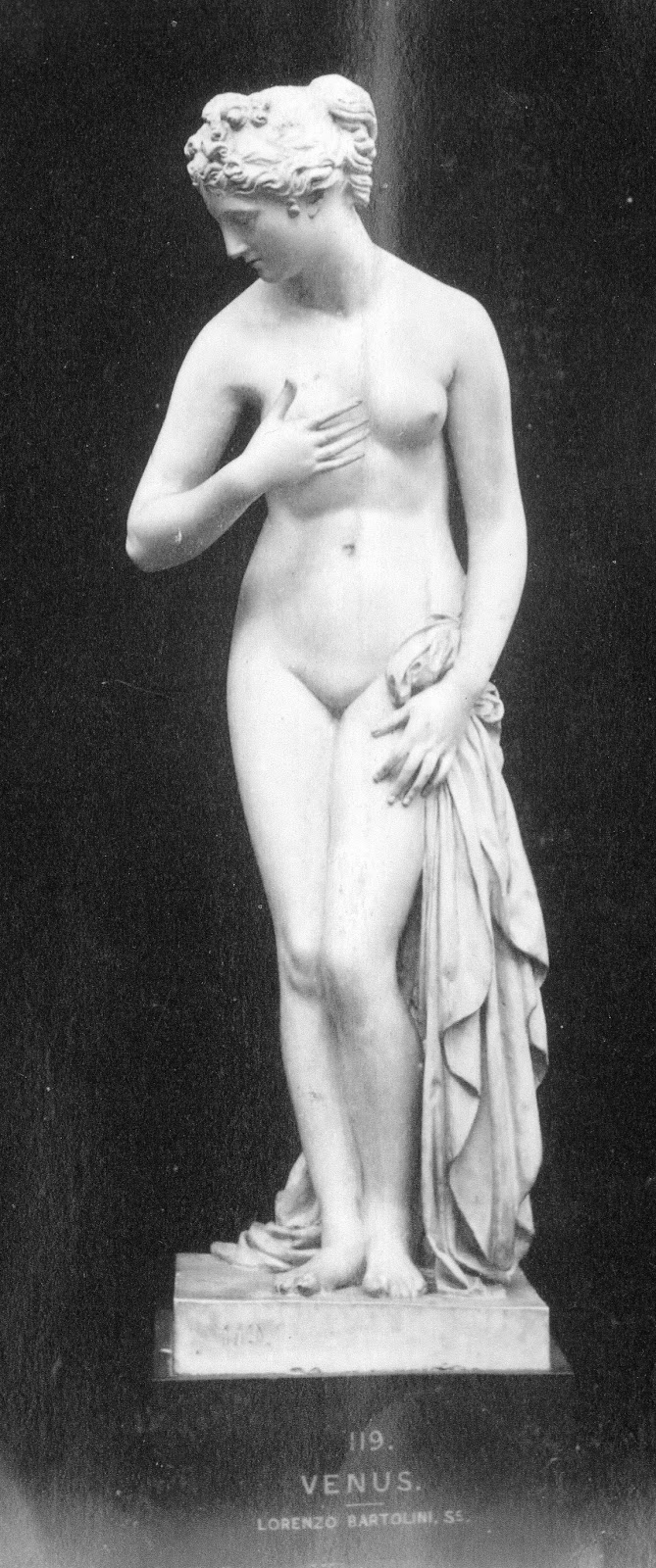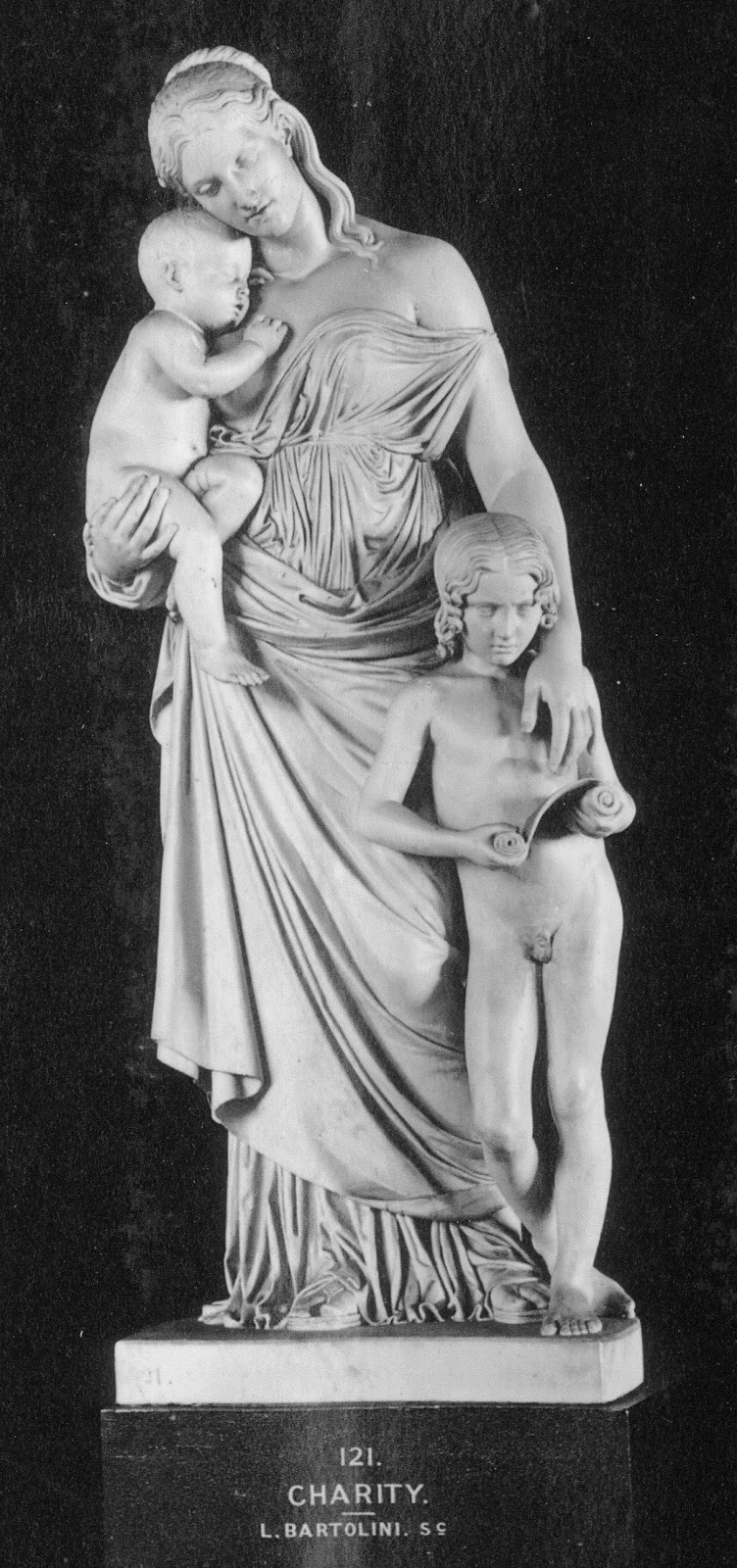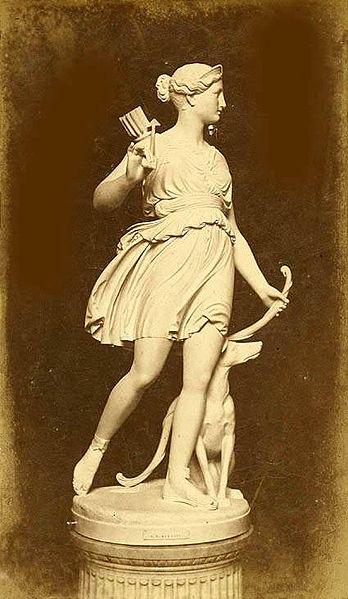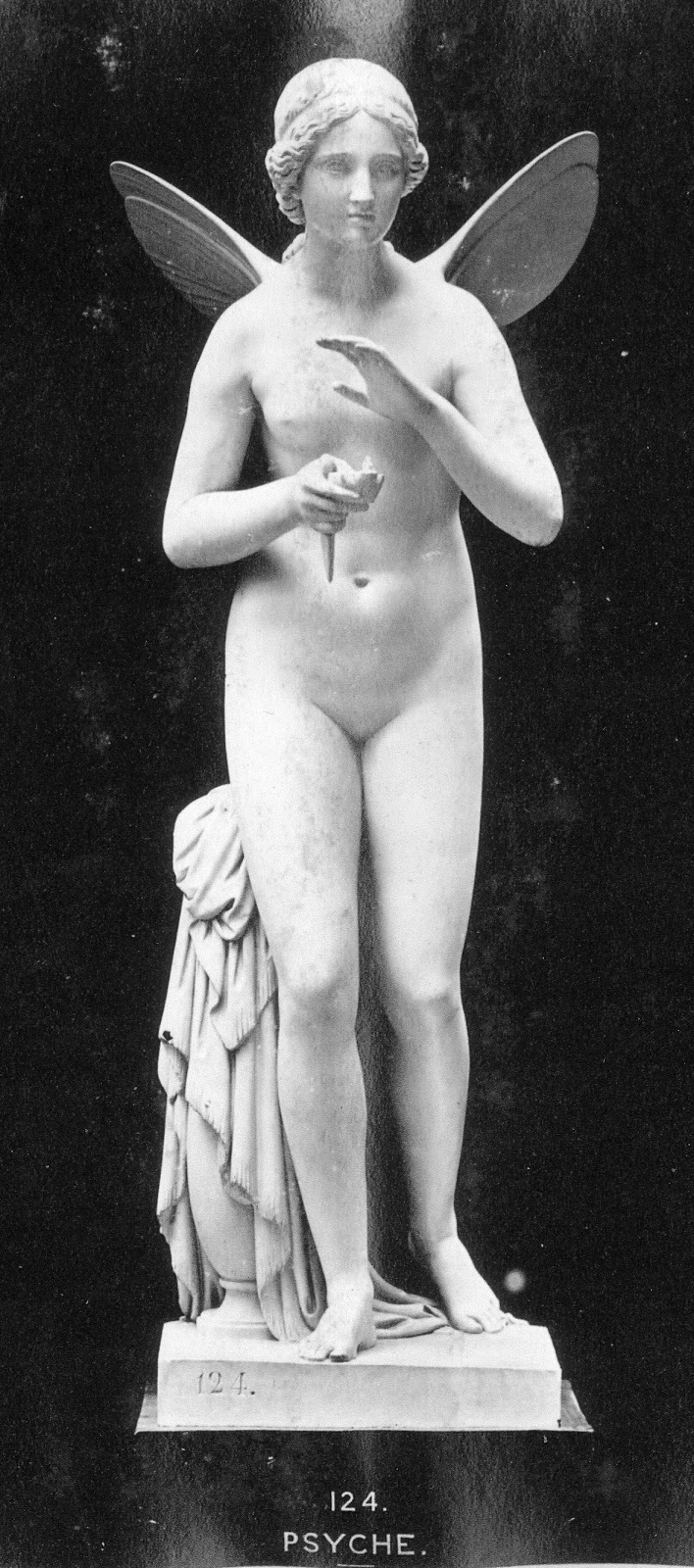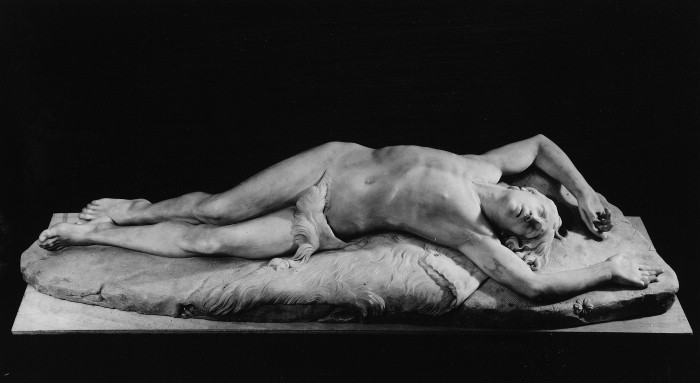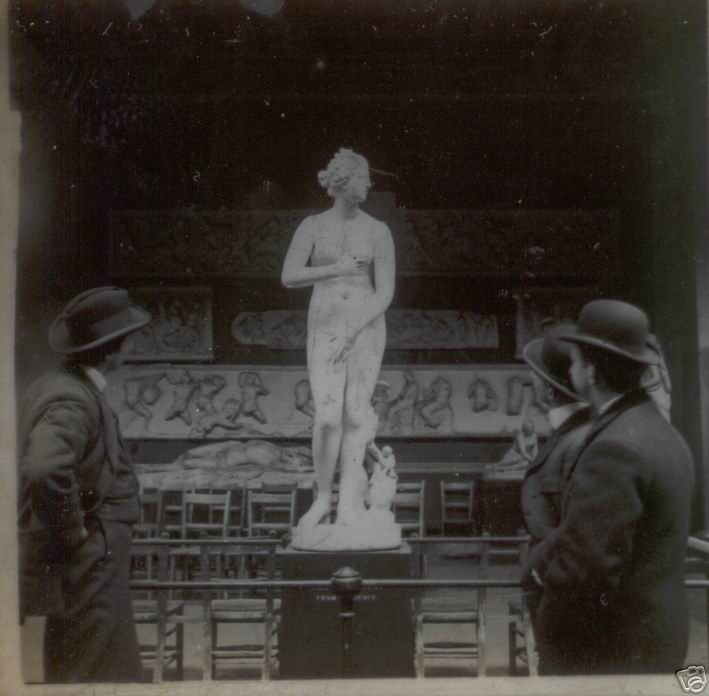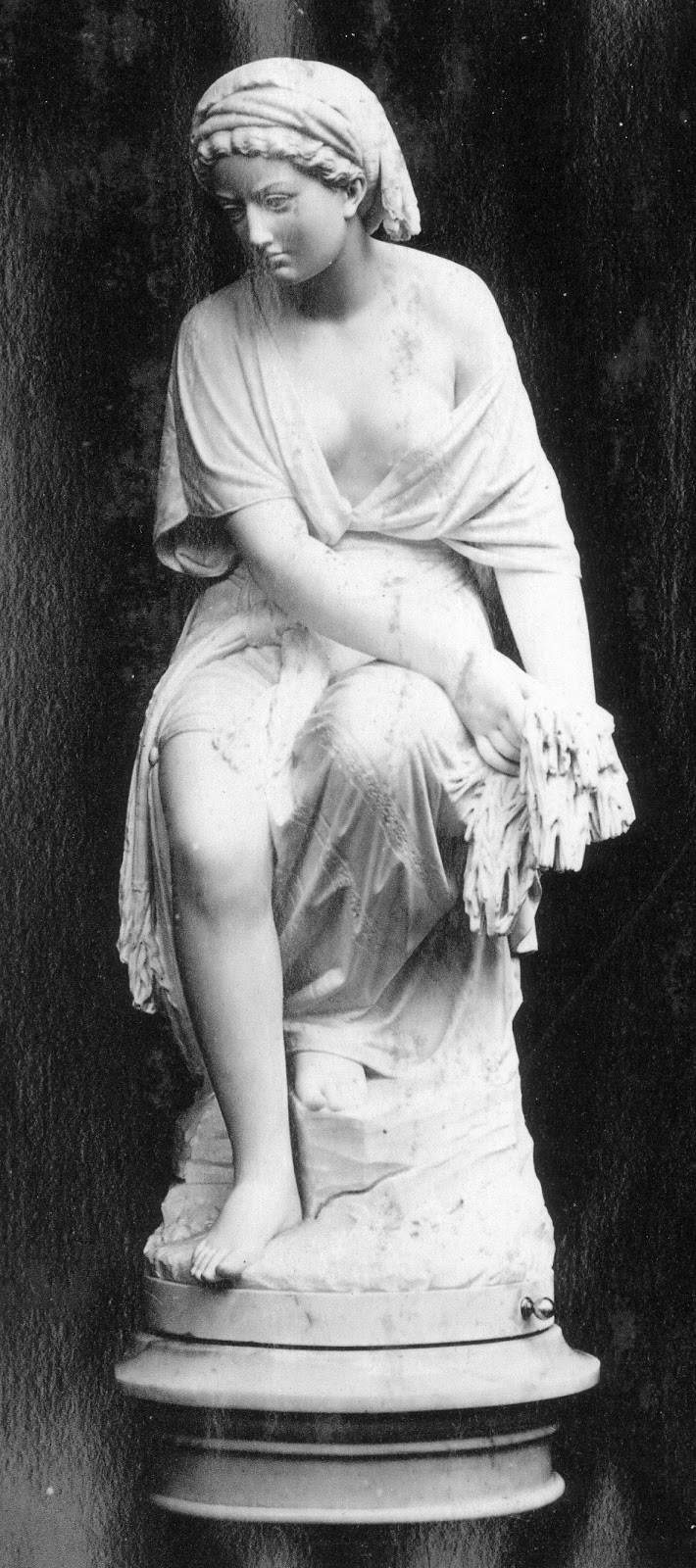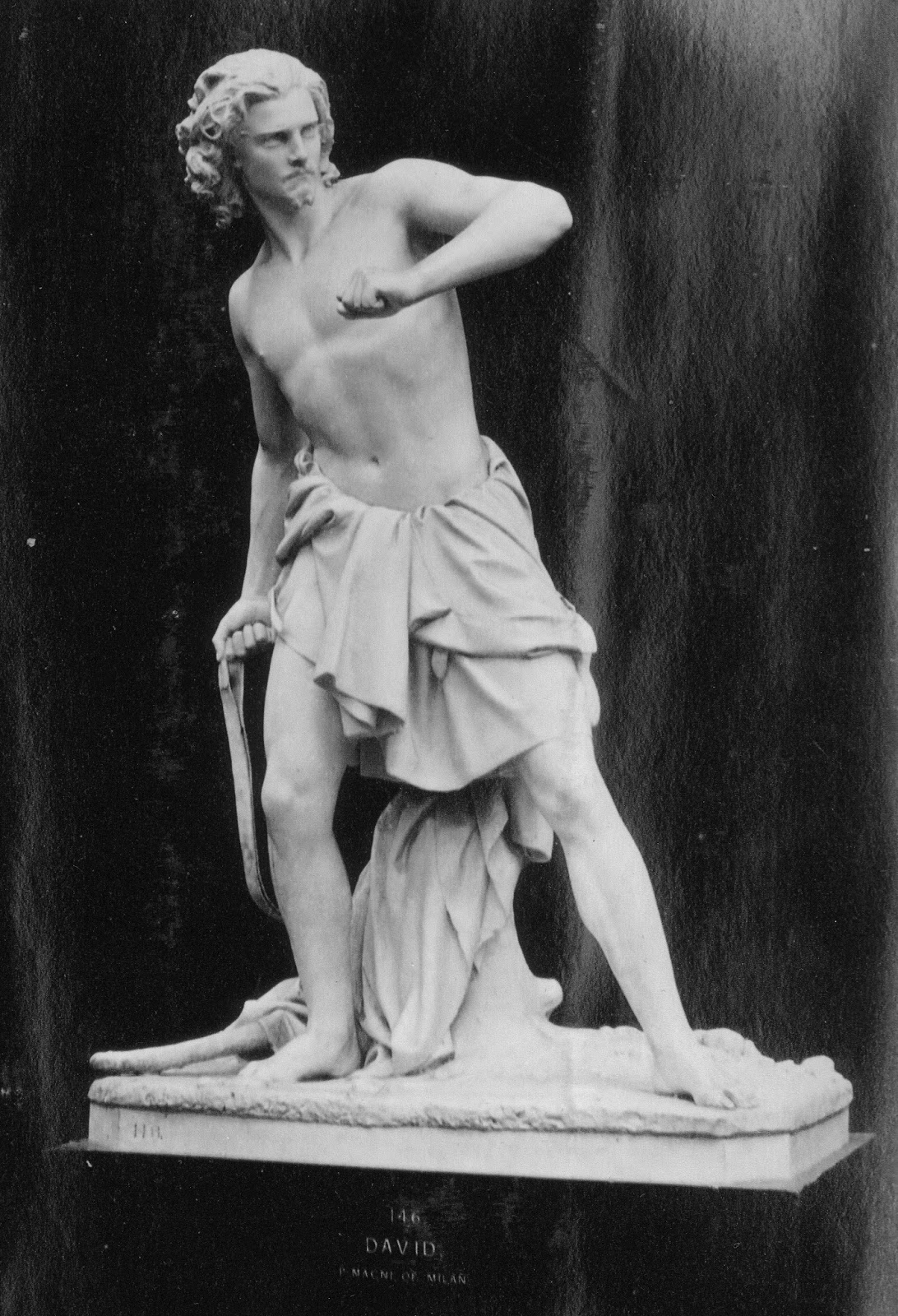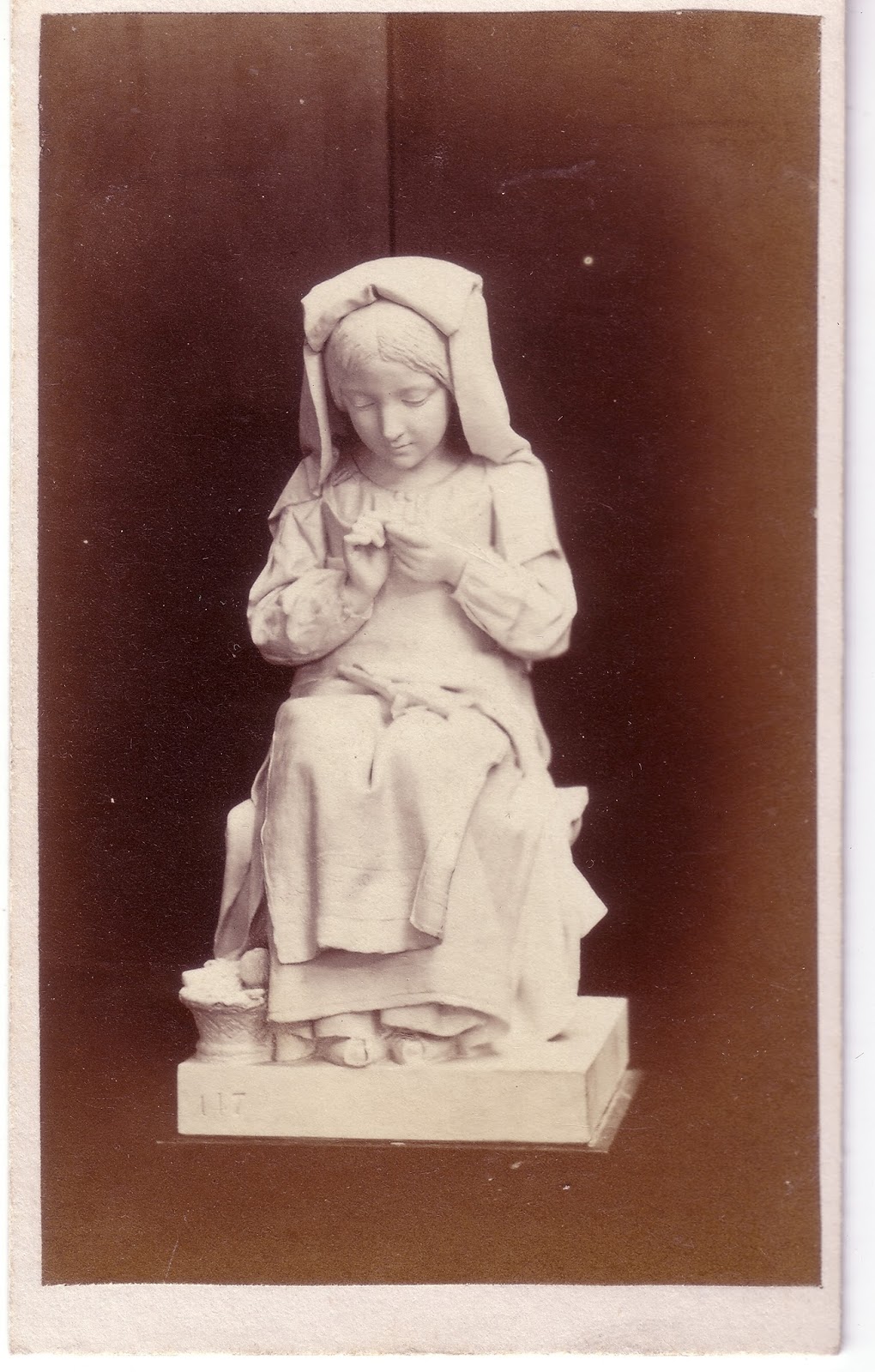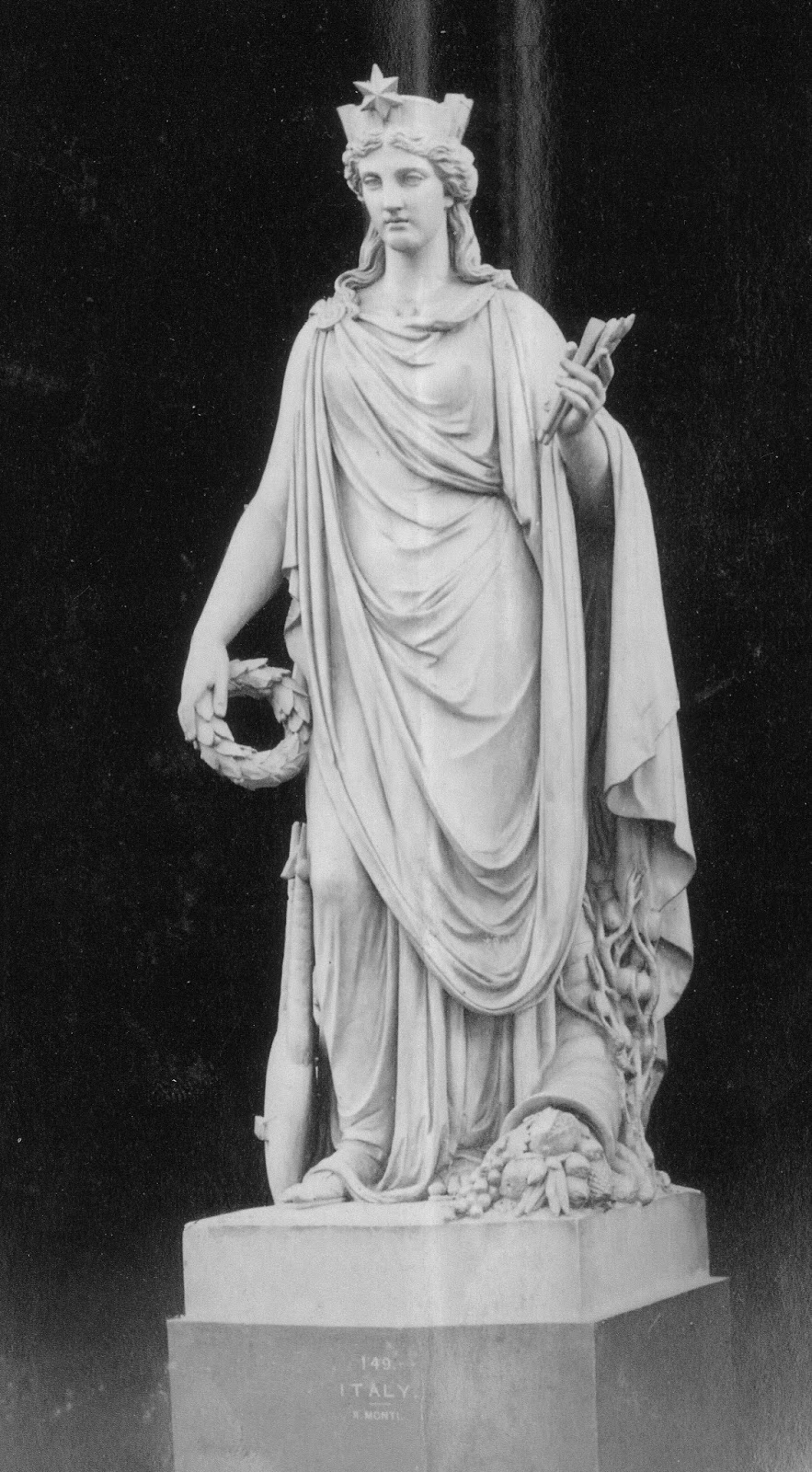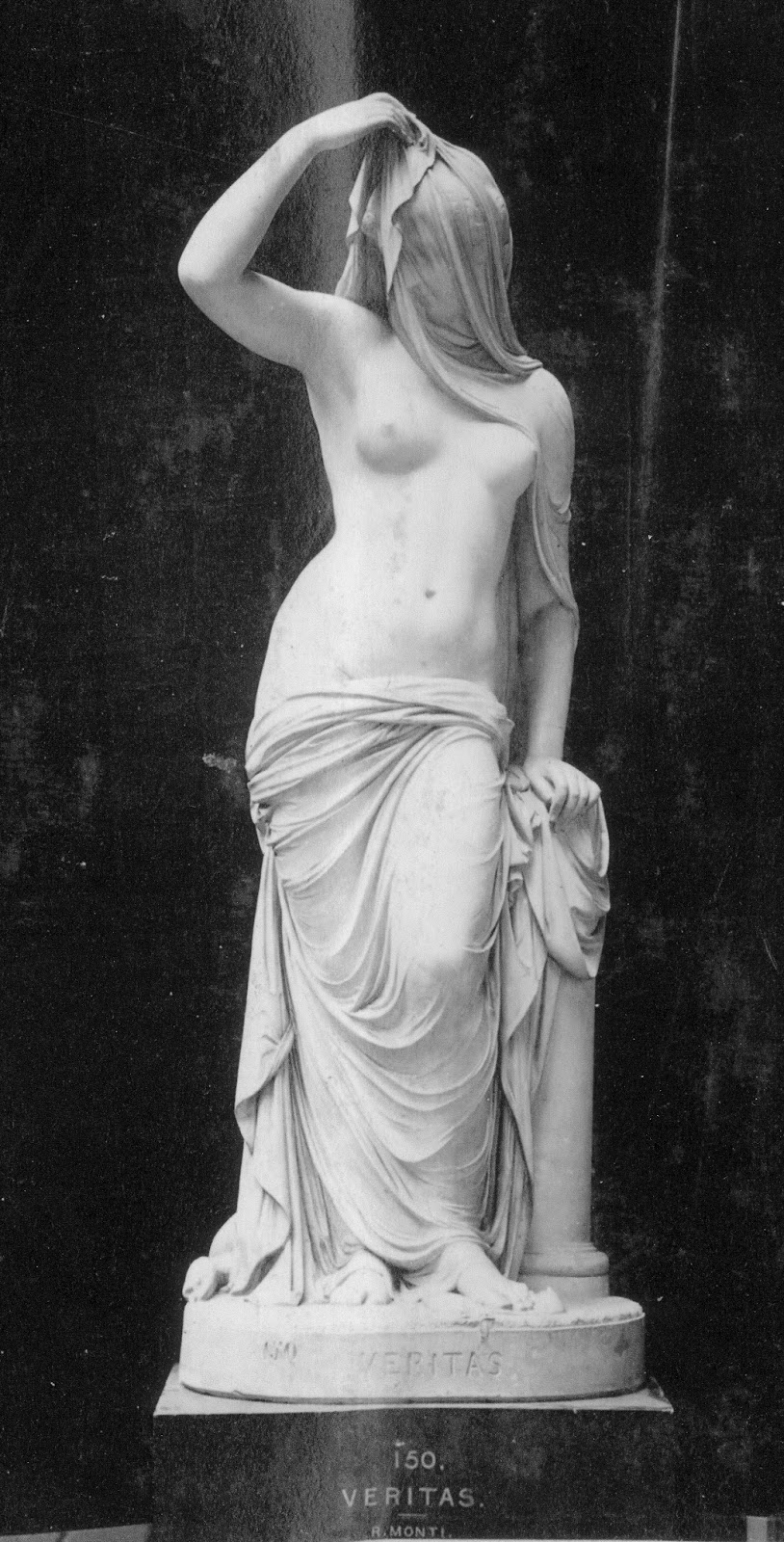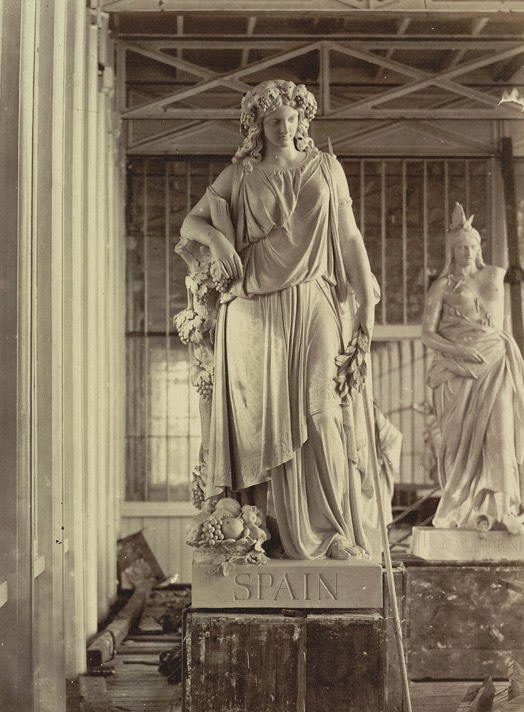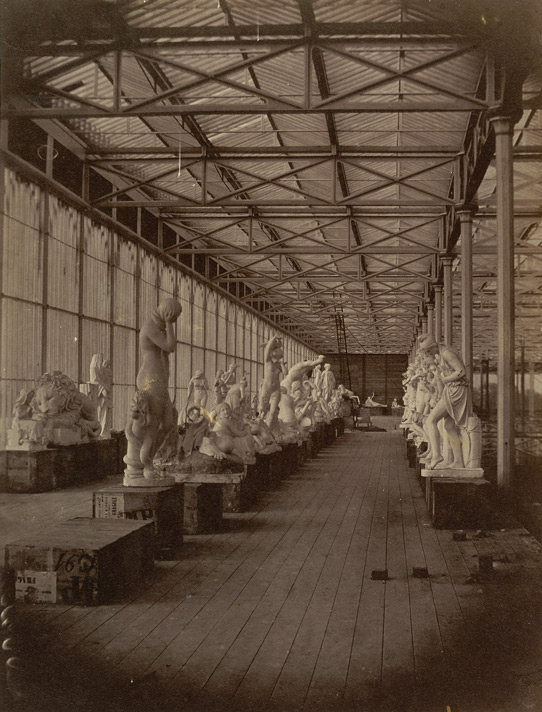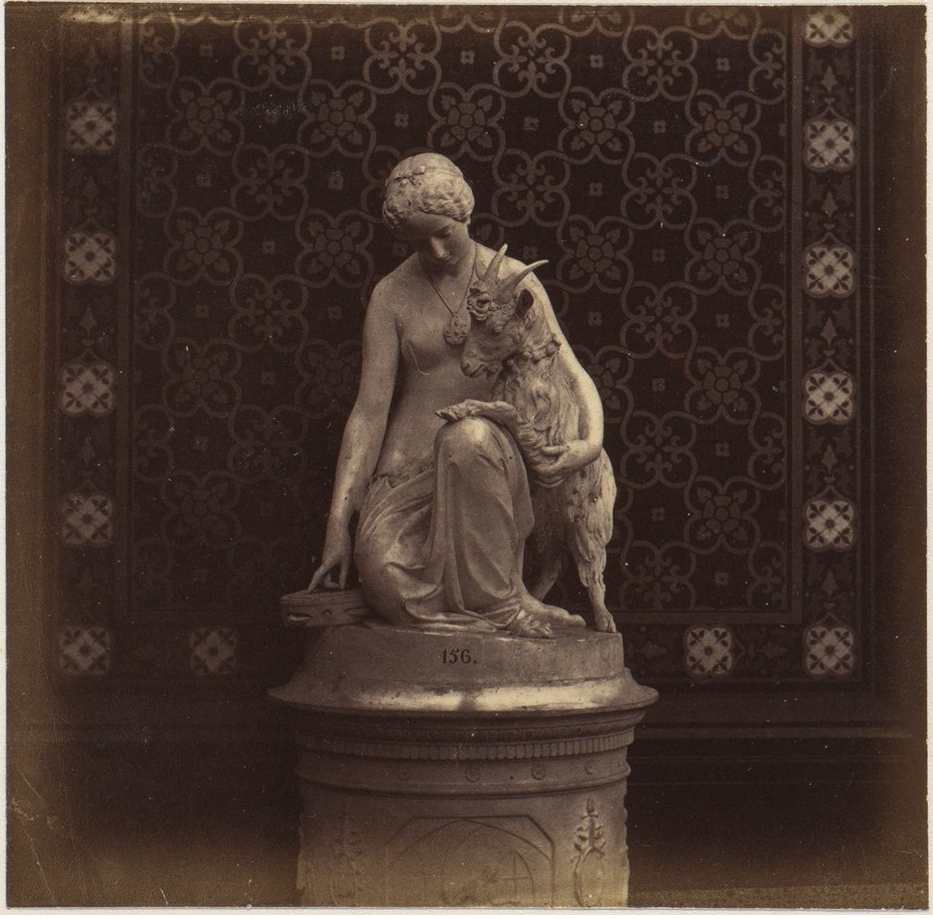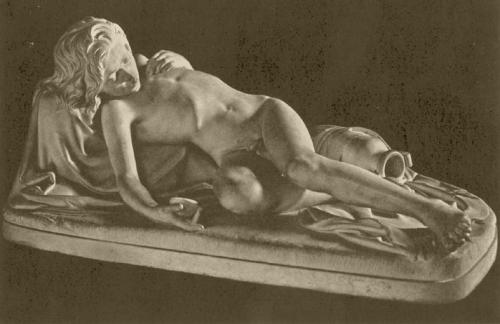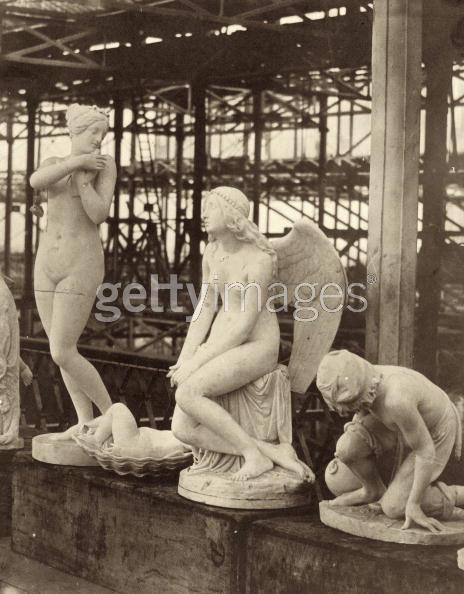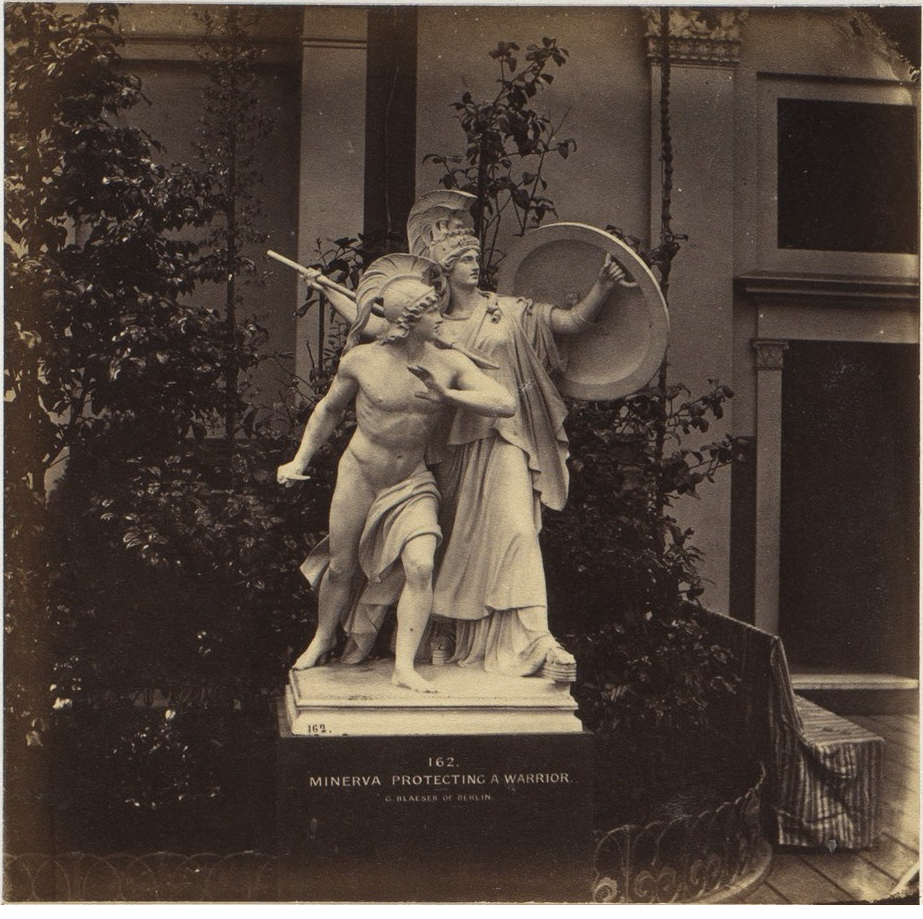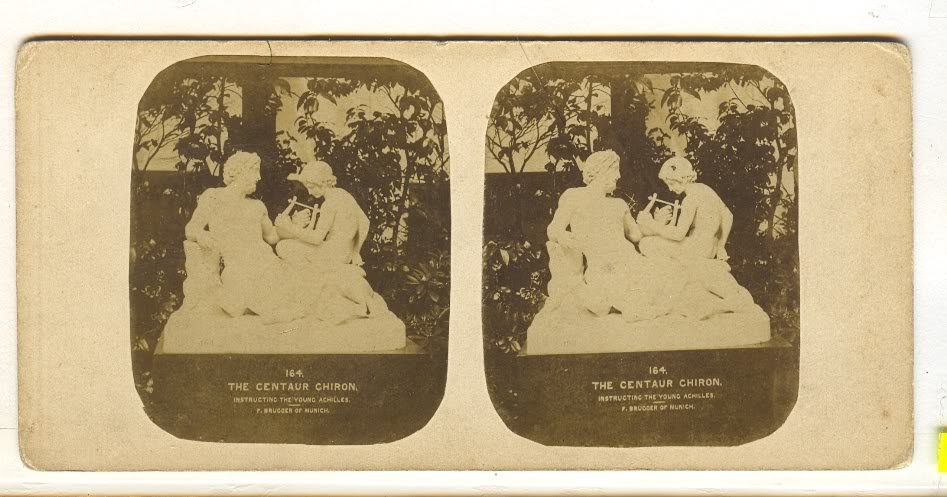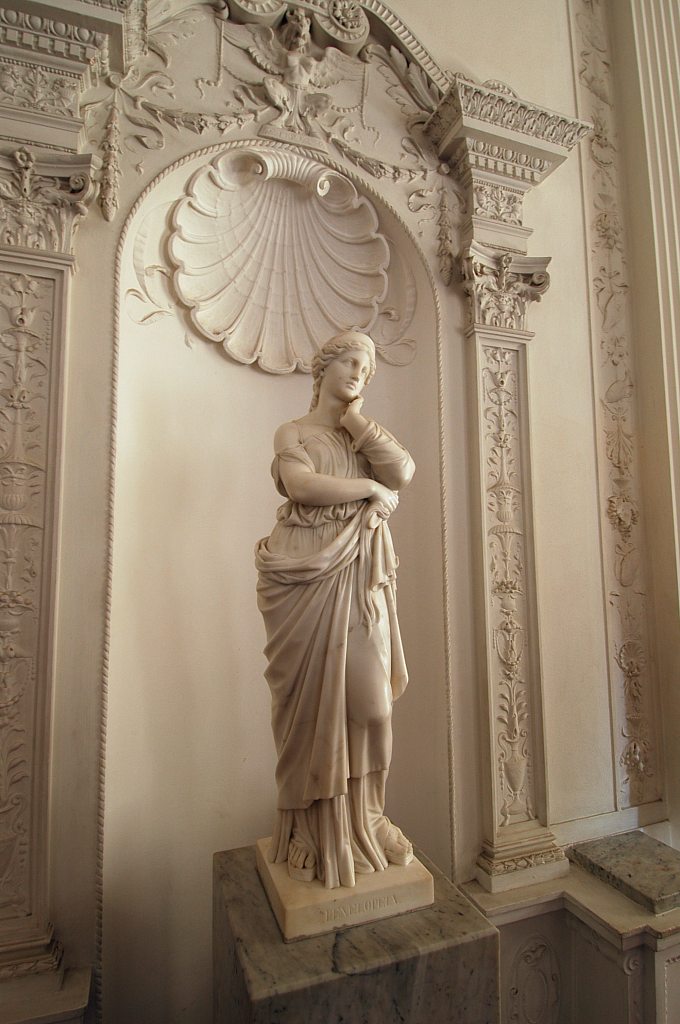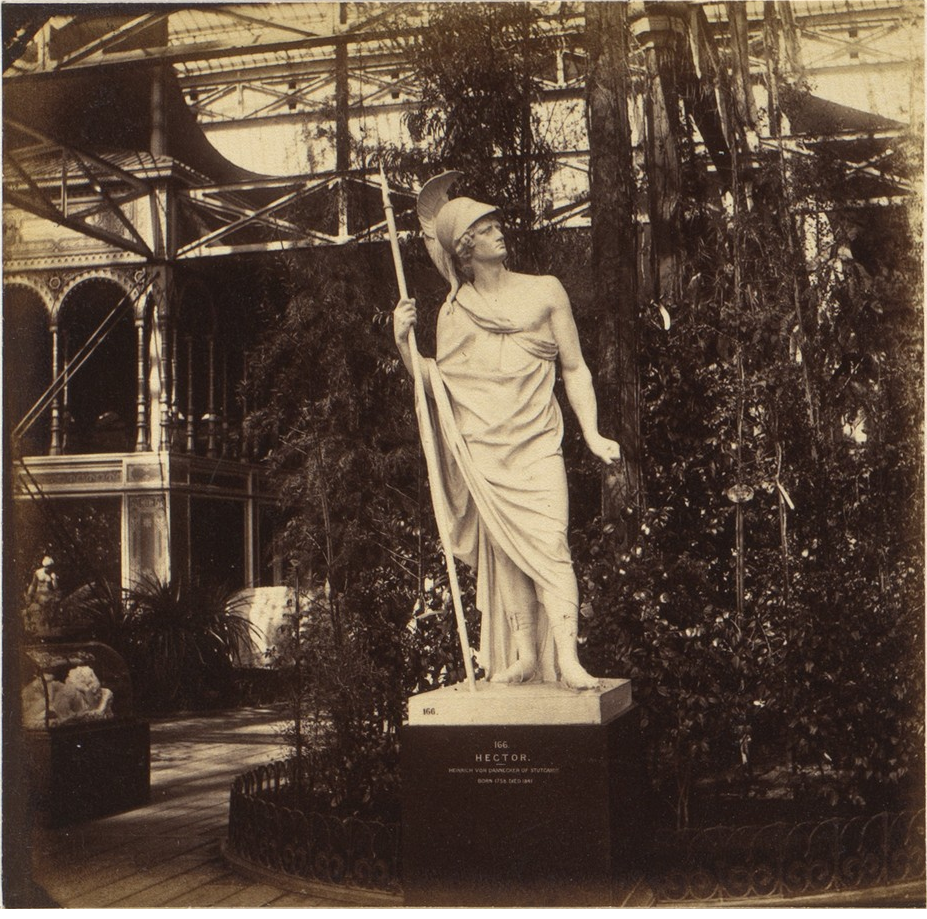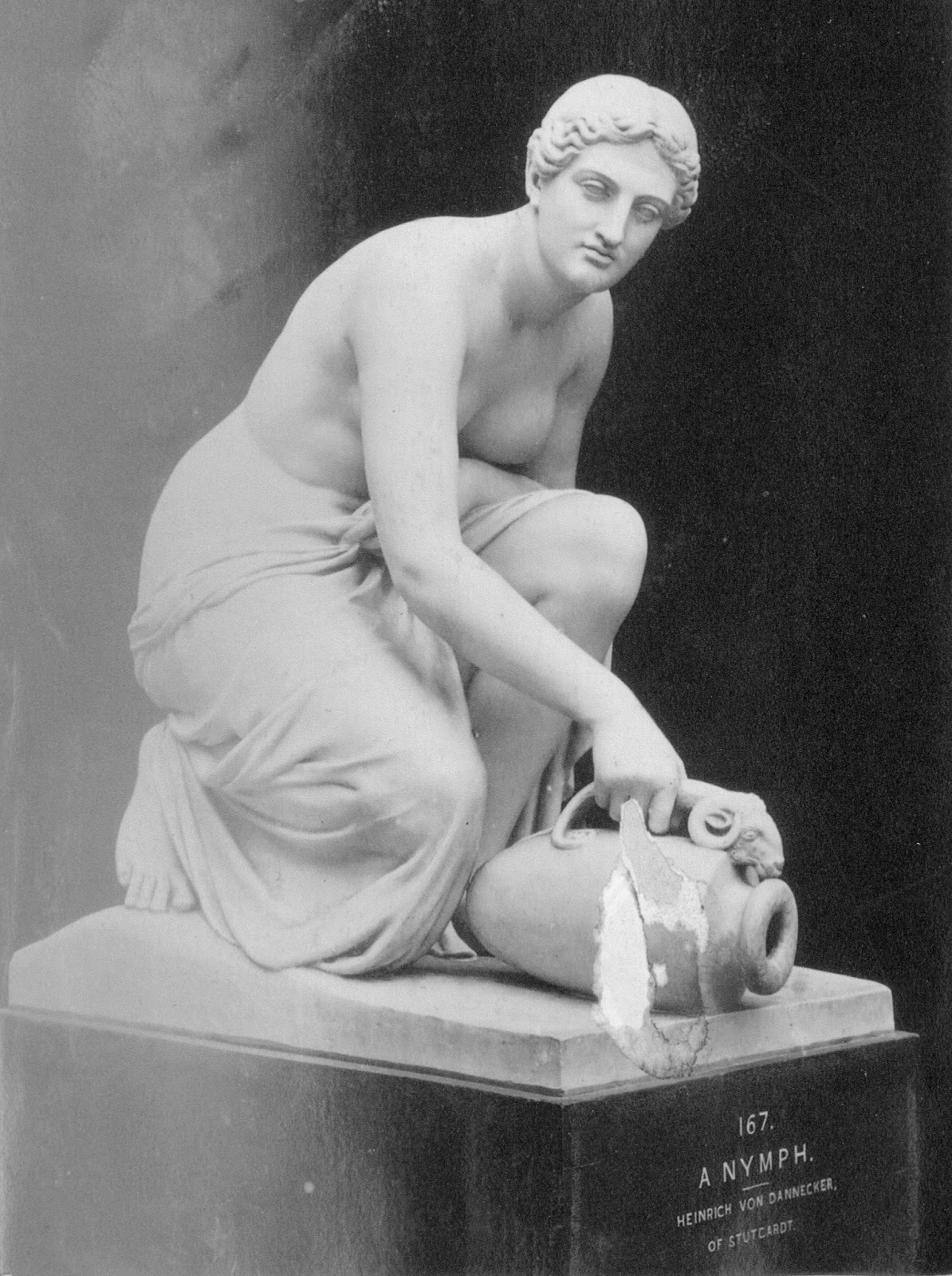ANTONIO CANOVA
1757 - 1822
Antonio Canova was born at Passagno, a little village in the Venetian territories ; and it is worthy of remark, that this insignificant hamlet, which before this time was not to be found in any map of Italy, now finds a place on almost every map. The parents of Canova were peasants, on the estate of Count Faliero, and the first proof he gave of his turn for art, was the model of a cow in butter, for the table of the count. His patron sent him to Venice, to study in the academy there. He gained, in a few years, the highest prize for sculpture, and was sent to Rome, in 1774, with a pension of 300 ducats. He had already modelled the group of Daedalus and Icarus, and on his arrival at Rome he produced, in clay, the group of Theseus and the Centaur. These works were not only full of promise, but in reality surpassed anything that had been produced for a long time. From the year 1783, his fame may be said to be established. In 1802, he was summoned to Paris by the Emperor Napoleon, whose bust he modelled, and he afterwards executed the colossal statue of the Emperor, which has since become the property of the Duke of Wellington. In 1815, he was again in France, with the title and honours of ambassador from the Pope, to reclaim the works of art which had been carried off from Italy by the French. On this occasion he visited England, and was consulted on the value of the Elgin marbles. He received at the same time commissions from the Prince Regent (George IV.), and from many of our nobility. On his return, the Pope created him Marquis of Ischia. In the later years of his life, Canova became extremely religious, and devoted a large portion of his fortune to the erection and decoration of a church in his native village ; ha also modelled a colossal statue of religion, which he presented to the Pope, for the purpose of being placed in St. Peter’s, at Rome. There was, however, something in the conception of this statue which did not please, and the cardinals were opposed to its being placed in the church. The sculptor, offended, sold all his property in the Roman States, and withdrew to Venice, where he spent the rest of his life, occupied with the decoration of his church at Passagno. He died at Venice in the year 1822. In the beginning of this century, Canova’s reputation was unrivalled ; he was styled the Phidias of his time ; but his claim to this supremacy is now disputed. It is generally admitted that the want of severity and purity of style in his classical subjects, and of deep feeling in his religious works, place him on a lower grade than that which he held in his lifetime. His faults are a leaning to the picturesque and sentimental, which degenerated in many instances into mannerism and affectation ; his women never look modest, and his men scarcely ever look manly. His chief merits consist in the softness and delicacy with which he worked the marble, and an attention to correct natural forms which had not been usual in the artists of the last century. By passing in review those of his works collected here (which are among his most celebrated), and comparing them with those of others, we shall perhaps be able to arrive at a just appreciation of his genius. They are all classical subjects (with one exception, the Magdalen). The style, too, is what is usually called classical, a mingling of the antique with the mannered sentimentalism of the Bernini school.

125. THE THREE GRACES.
Group. Life size.
The Graces, styled by the Greeks the Charities, were three lovely sister goddesses, whose names were Aglaia, Thalia, and Euphrosyne. They presided over beneficence, good temper, and all the kindly feelings, which express harmony of soul. They were the daughters and constant attendants of Aphrodite (Venus), to show that beauty should be accompanied, not only by grace of person, but grace of mind ; and as grace of mind supposes a cultivated intellect, they were the chosen companions of Apollo and the muses, and were worshipped in the same temple. We are told that in the earliest times the Greeks represented the Graces or Charities as veiled, to express their modesty, but afterwards to express their innate putrity and sincerity, they were required to have the attributes of innocence and truth, that is, they were to be represented without any drapery, disguise, or ornament of any kind. The observer will feel that Canova has departed from the purity of sentiment suggested by the exquisite Greek allegory ; that the expression of grace is here outward rather than inward, and in fact verges on the conscious, the artificial, and even the affected.
The original marble group was executed for the Empress Josephine, and after the overthrow of Napoleon, was purchased by the Duke of Bedford. There are many repetitions, one of them in the possession of the Queen.
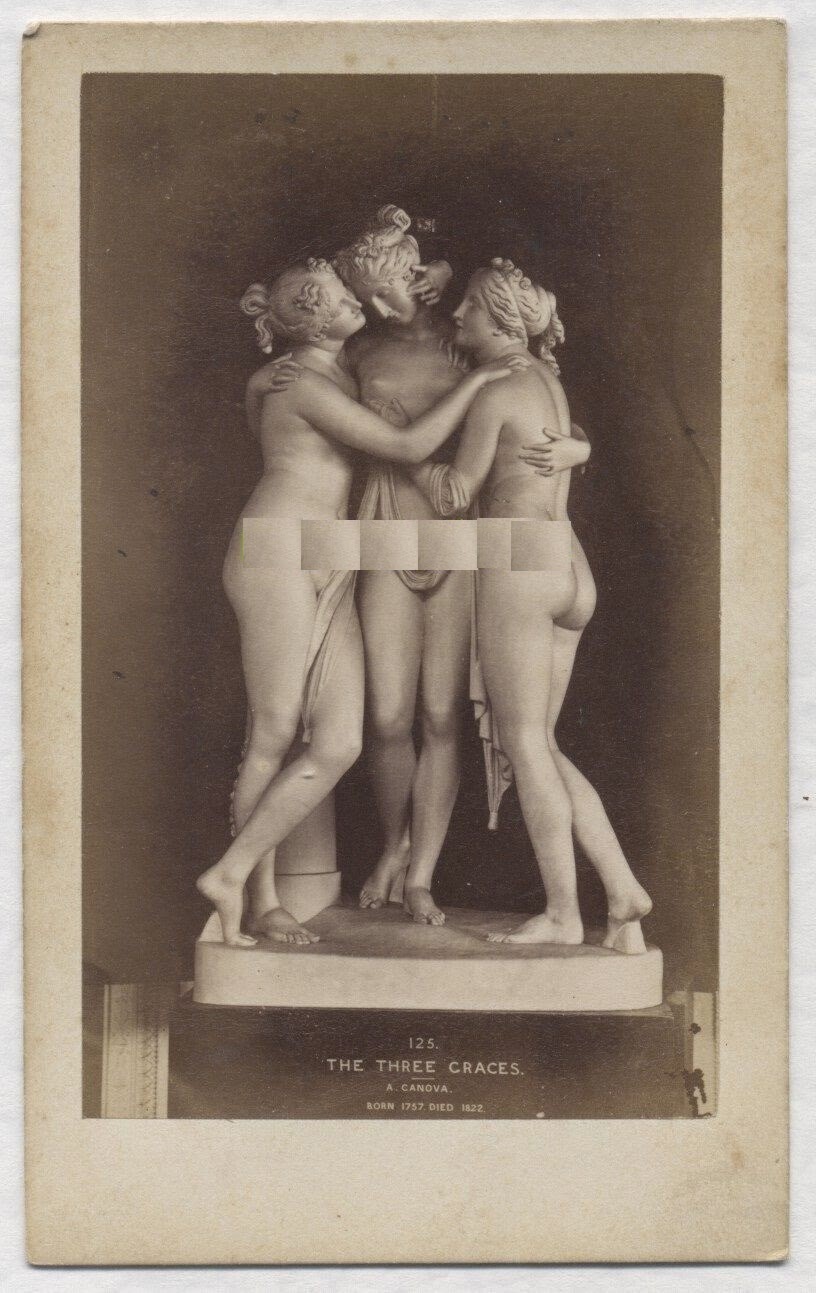
126. VENUS AND ADONIS.
Group. Life size.
Without going into the famous allegorical myth of Aphrodite and Adonis, which is of Asiatic origin, it is only necessary to recall here the Greek legend. Venus, more properly Aphrodite, loved the beautiful youth Adonis, and endeavoured in vain to detain him in her arms from the chase, wherein he was killed by a wild boar. The sculptor has represented the parting of the lovers : Adonis holds the Goddess half embraced, while she seems to plead in vain.
The original marble group, a subject well suited to the genius of Canova, and certainly one of his finest works, was executed for the Marchese Berio of Naples, and after his death came into the possession of Signor Favre di Ginerva, also of Naples.
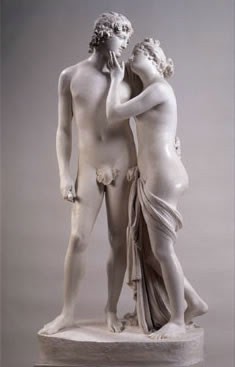
127. ENDYMION.
Statue. Life size.
He reclines sleeping, his dog watching at his feet. Endymion, according to the Greek story, was a beautiful Shepard of Mount Latmos, and beloved by Diana (or the Moon). Poetically, he is the personification odf sleep (which was the boon he required of Jupiter) ; his greek name Endymion, signifies a being who comes gently over one; he slumbered in the cave of
The original marble, which is a late production of the artist, executed about 1820, is now in the possession of the Duke of Devonshire.

128. NYMPH WITH A CUPID.
Group. Life size.
Sometimes called “the Nymph awakened by Love.” A beautiful female figure on a couch appears to waken up to the sounds of the lyre which cupid is playing at her feet. This statue is especially distinguished by that meretricious sentiment which was Canova’s great fault.
The original marble was executed for George IV., and is now at Buckingham Palace.
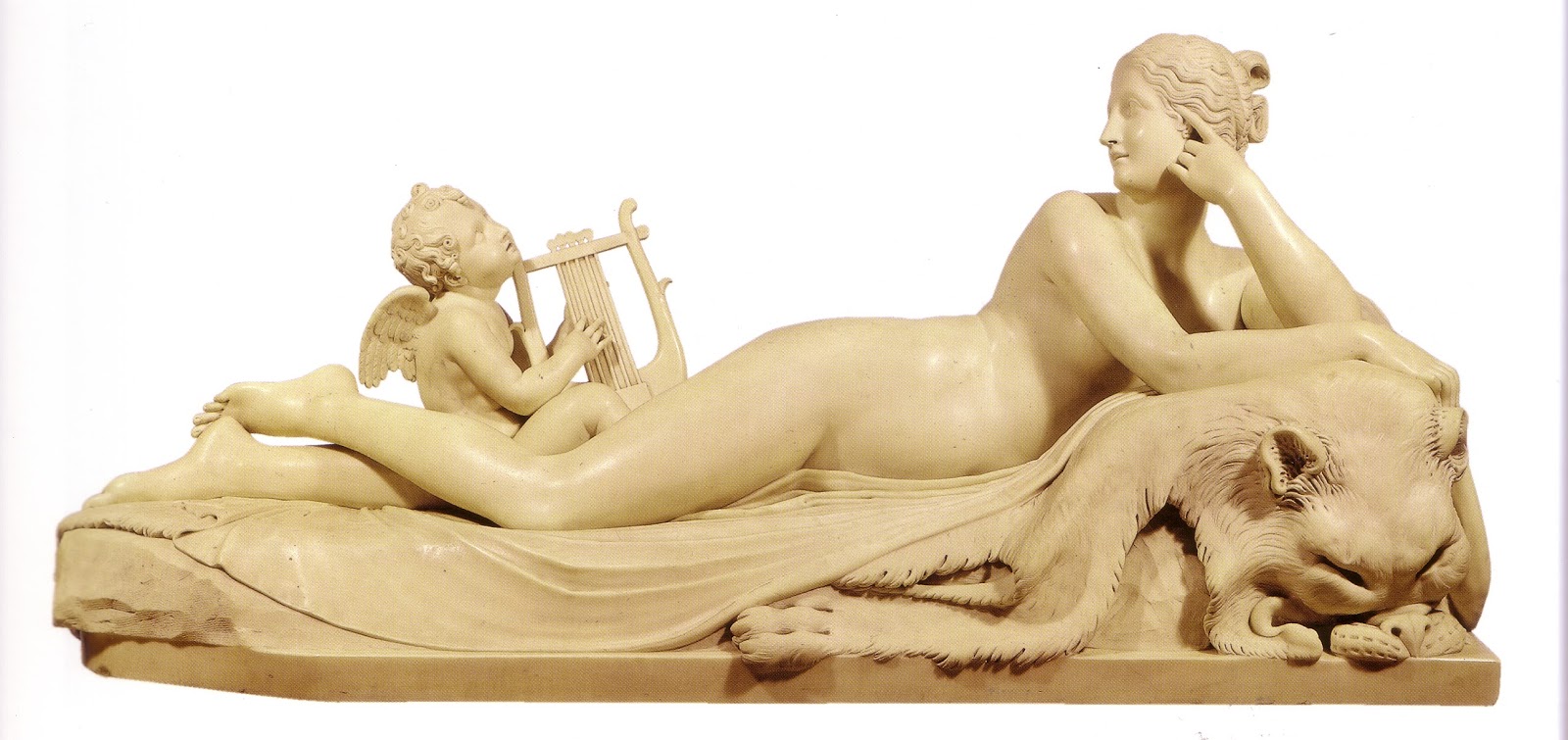
129. PARIS.
Statue. Heroic size.
Paris, the son of Priam, King of Troy and his wife Hecuba, was exposed after his birth on Mount Ida, where for some years he lived as a Shepard. In this character he was selected by the gods to adjudge the golden apple, which was to be the prize of the fairest of the goddesses ; Juno, Minerva, and Venus, who promised him in return the possession of the most beautiful woman in the world. With her assistance, he carried off Helena, hence the siege of Troy, and the destruction of the country and family of the ravisher. Paris is here represented as the young Shepard of Mount Ida. He stands in an easy elegant attitude, holding in his hand the fatal apple of discord, and wearing the Phygian cap. The faults of Canova become merits in a subject like this, and the effeminate grace of the figure well expresses the character of Paris as exhibited in Homer.
The original marble, ordered for the Empress Josephine in 1813, was afterwards purchased by the King of Bavaria, and is now at Munich. A repetition is in the possession of the Emperor of Russia.
[1807/16 205 x 99 x 55 cm]
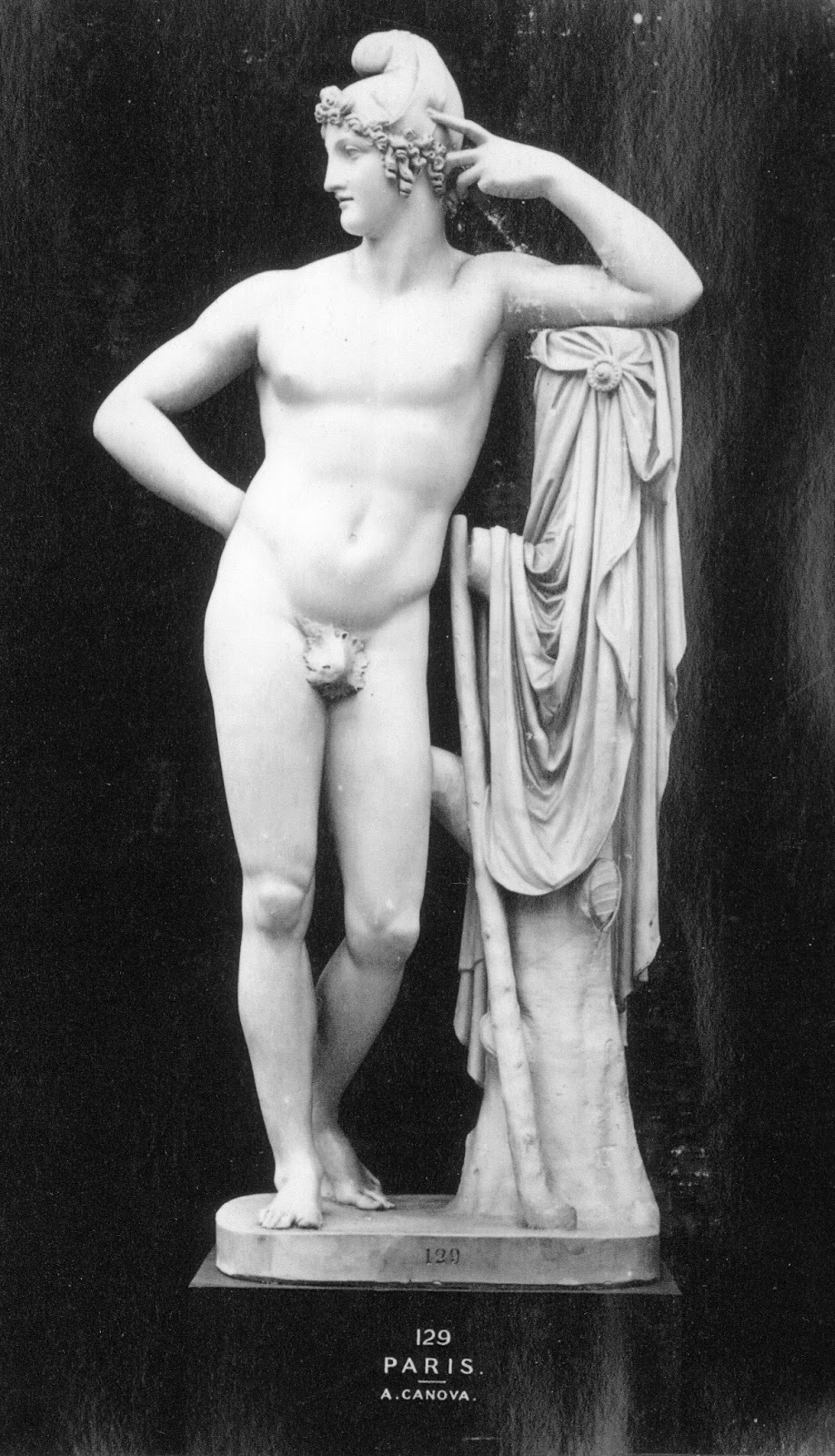
130. TERPSICHORE.
The Muse who presided over dancing is here represented standing, holding in her left hand the lyre, and in the other the plectrum, the little instrument used to strike the chords. The fault of this statue is that Canova, instead of giving us the Muse who inspired “the poetry of motion,” seems to have had a dancer for his model ; it is one of the coldest and most affected of his compositions.
The original statue, which was intended for the Countess of Albany, is now the property of Count Somariva, and I believe, in his Villa on Lake Como.
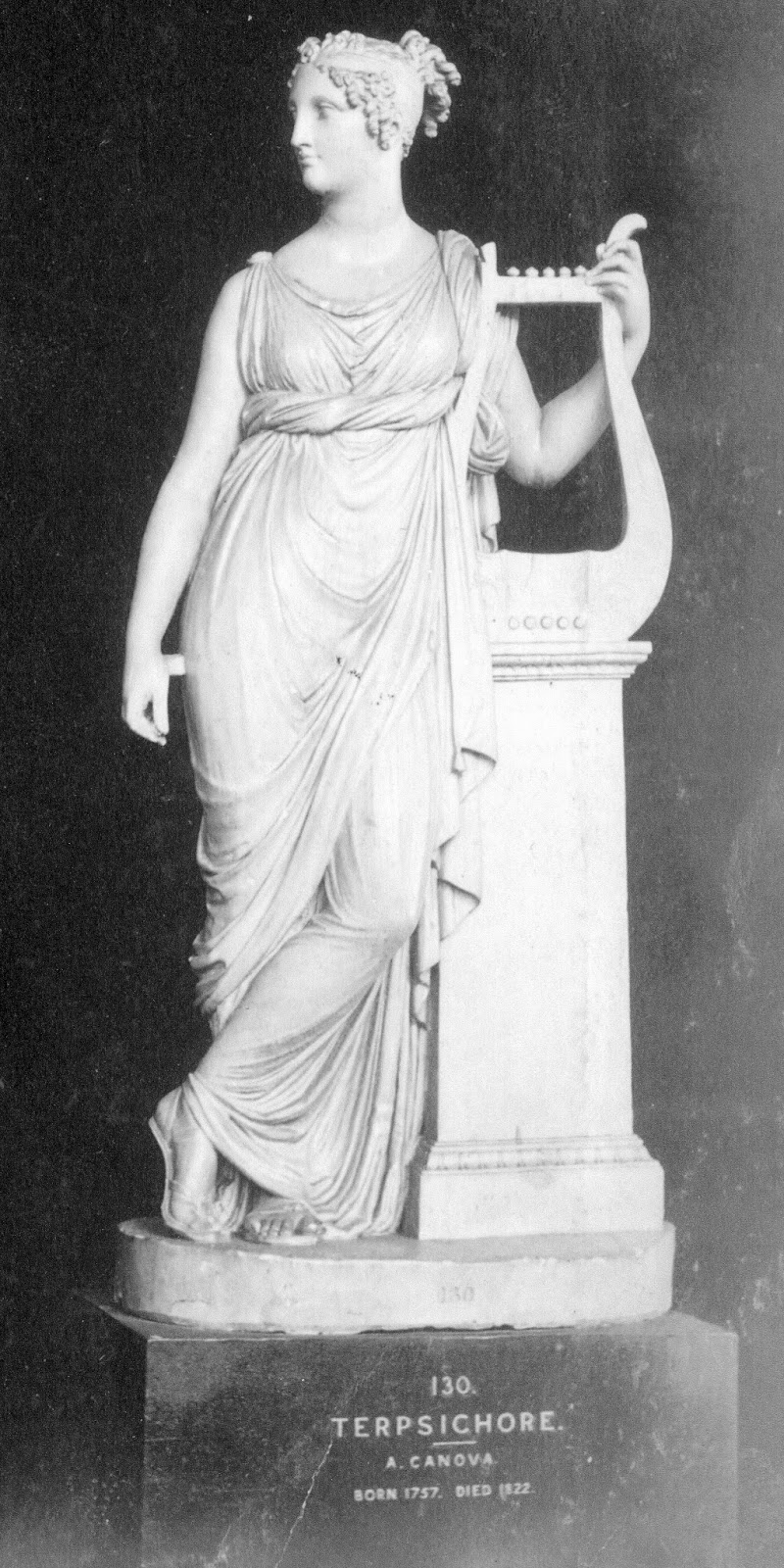
131. VENUS LEAVING THE BATH.
(Venus sortant du Bain.)
Statue Life size.
This statue is also known as “the Venus of the Pitti Palace.” She stands holding up her drapery pressed to her bosom, and the head turned to the left. A casket on the ground. This statue has been criticised, and with reason, as much more like a fine lady, too conscious of her undress, than as representing the Goddess. When the Venus de’ Medeci was carried off from Florence by the French, this statue had the honour of being placed on the empty pedestal ; but on the return of the divine occupant it was placed in the Pitti Palace, in a room panelled with mirrors.
There are repetitions of the Pitti Venus in the possession of the King of Bavaria, Lord Landsdowne, and others.
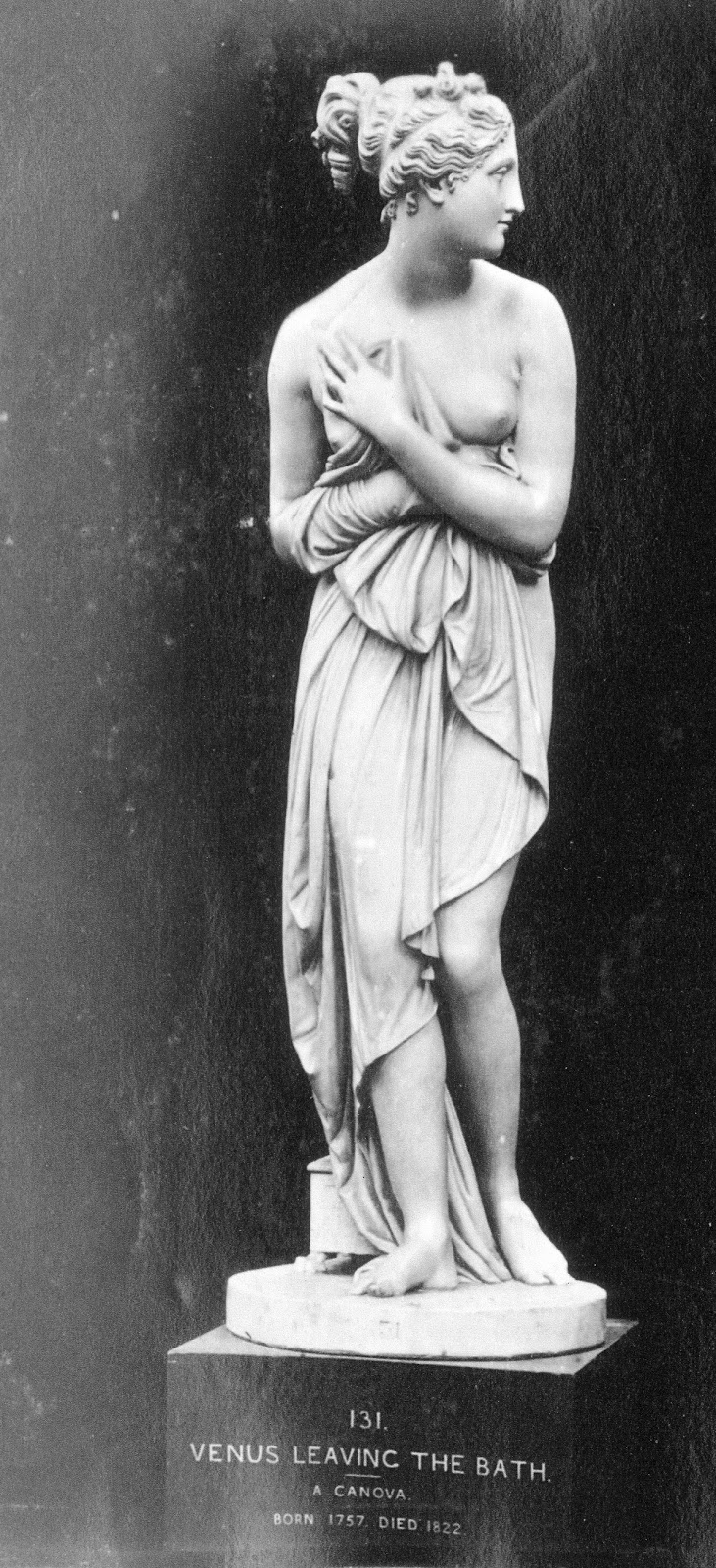
132. [Thomas Hope] VENUS.
The attitude slightly different from the last and with less drapery. The casket is omitted. The marble is at Paris, and is one of Canova’s finest works.
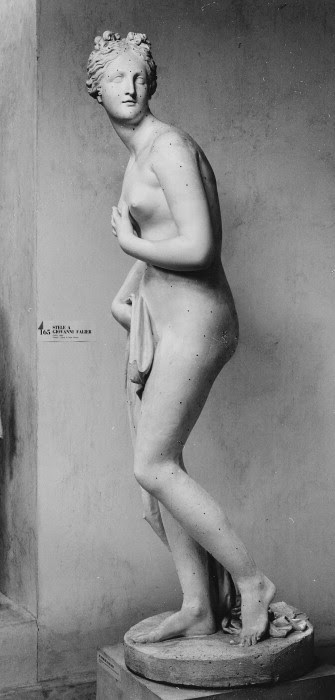
Leeds City Art Gallery
The Hope Venus is the last in a seires of figures of Venus by Canova, all inspired by the Greco-Roman Medici Venus in Florence. The sculptor's interest in this subject arose from a commission from Felix Bacciochi, King of euturia, in 1803 to make a replica of the celebrated ancient statue, which had been removed by Napoleon to Paris.
Canova was famed for his ability to render marble as flesh and his suavely erotic female figures were eagerly sought by wealthy foreigners who visited his studio in Rome. One such was Thomas Hope (1769 - 1831) architect, interior designer and passionate collector. Hope gave his Venuspride of place in a gallery of his mansion and private museum in Duchess Street, London. Removed by his heirs to his country residence, Deepdene in Surrey, it was eventually sold [1917] in London by his great grandson Lord Francis Pelham Clinton Hope. The purchaser was an eminent chemical manufacturer, Edward Allen Brotherton (later Lord Brotherton), who paid 1100 guineas for it and displayed it in the entrance hall of his residence, Roundhay Hall in Leeds. On his death it was inherited [1930] by his niece-in-law Dorothy Una Ratcliffe, a glamourous lady renowned for her volumes of Yorkshire lyrics who, in the late 1950's and early 1960's, dispersed most of her colection around local galleries and museums. Art Treasure of England. Royal Academy 1998
There was a marble copy by the Grand Fountain, this is all that is left, by the Rangers Hut in the Park.

133. HEBE.
Statue. Life size.
The goddess of eternal youth, and the cup-bearer of the gods, is represented here with the vase in one hand, and the cup in the other, as about to pour out the nectar. No work of Canova has been more admired, nor more often repeated in every form than this figure of Hebe ; but like most of his works, it sins against pure taste, and has too much the air of a young bacchante.
The original marble was executed in 1796 for Count Albrizzi, of Venice ; a repetition, now in the possession of the Emperor of Russia, was executed for the Empress Josephine ; another slightly varied, for Lord Cawdor ; a third for the Countess Guicciardini of Florence ; a fourth for the King of Prussia ; and there are innumerable copies.

134. PSYCHE.
Statue. Life size.
Called the Psiche Fanciulla. Psyche, who, according to the beautiful Greek myth, is the personification of the soul, and whose emblem was the butterfly ; is represented here as a lovely, innocent maiden, holding in her right hand a butterfly, which she places on the open palm of her left hand, and seems to contemplate it with a sweet thoughtfulness. This graceful statue is also a favourite work of Canova’s, and has been often repeated.
The original conception, which was first modelled in 1789, was executed in marble for Mr Blundell; the same, or a repetition, was presented by Napoleon to the Queen of Bavaria in 1807. There are innumerable copies. Canova inscribed beneath this Psyche two lines from Dante –
“Non v’accorgete voi che noi siam vermin
Nati a formar l’angelica Farfalla?”
Bethink ye not that we are only worms#
Born to produce the angel butterfly?
Which fixes his intention as to the significance of the figure.
[1793/94 150 x 50 x 60 cm]
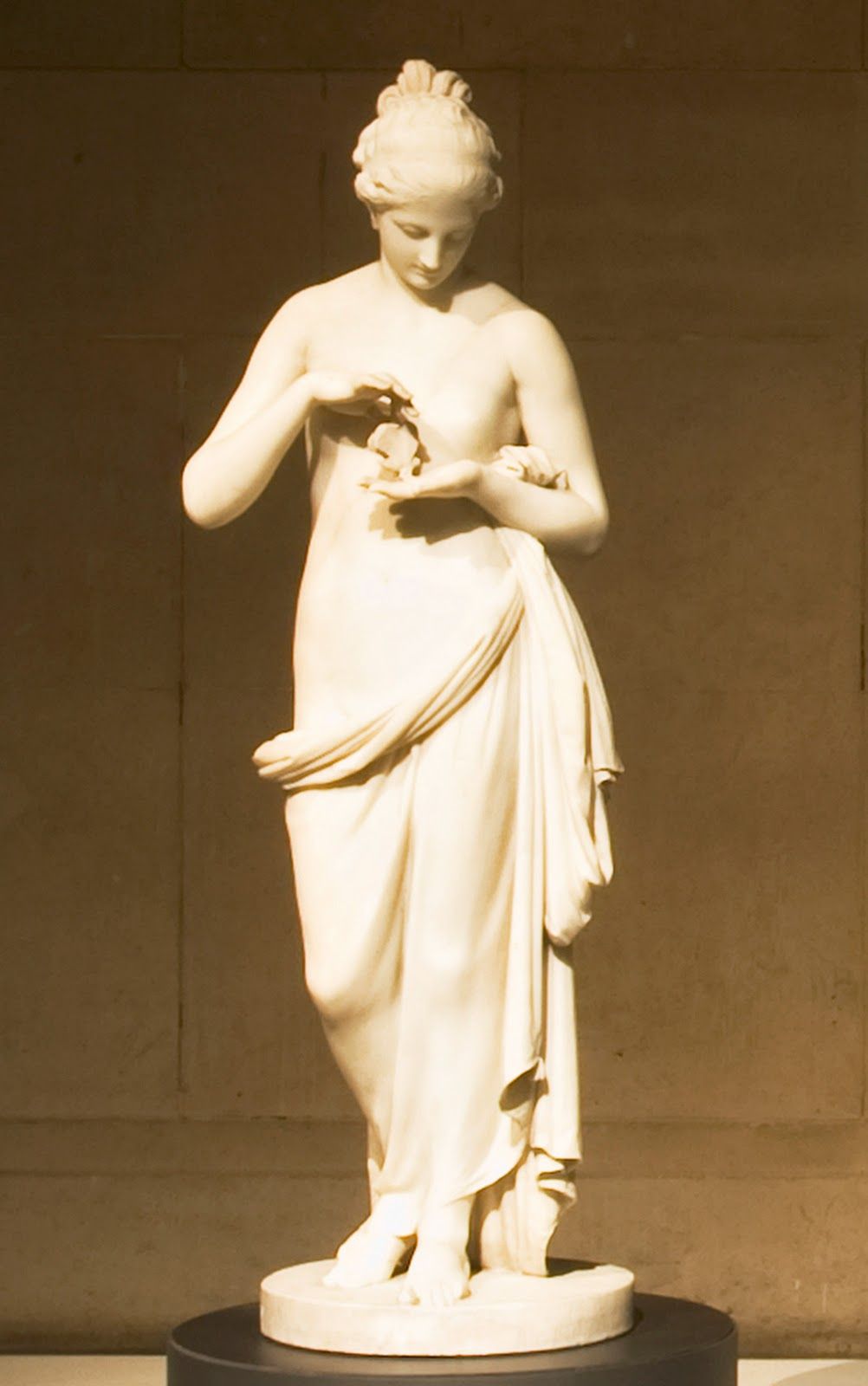
135. MARS AND VENUS.
Group. Heroic size.
Amongst the ancient Greeks war was represented by two divinities ; Athena or Minerva, represents thoughtfulness and wisdom in the affairs of war, and protects men and their habitations during its ravages. Ares, or Mars, on the other hand, the masculine personification, represents mere force ; he loves war for its own sake, delights in the din of battle, the slaughter of men, and the destruction of cities. This fierce and gigantic, but withal handsome god, loved, and was beloved by Aphrodite (Venus), and they are frequently represented together. In this group, Mars, wearing his helmet, and holding his lance, bids adieu to Venus, who endeavours, and as it appears, not vainly, to detain him from the field of battle. Such is the sentiment of the conception, which was intended to represent Peace and War : it will be observed that the cornucopia lies at the feet of Venus.
The original marble was commanded by George IV, as a memorial of the peace of 1816, and is now in Buckingham Palace.
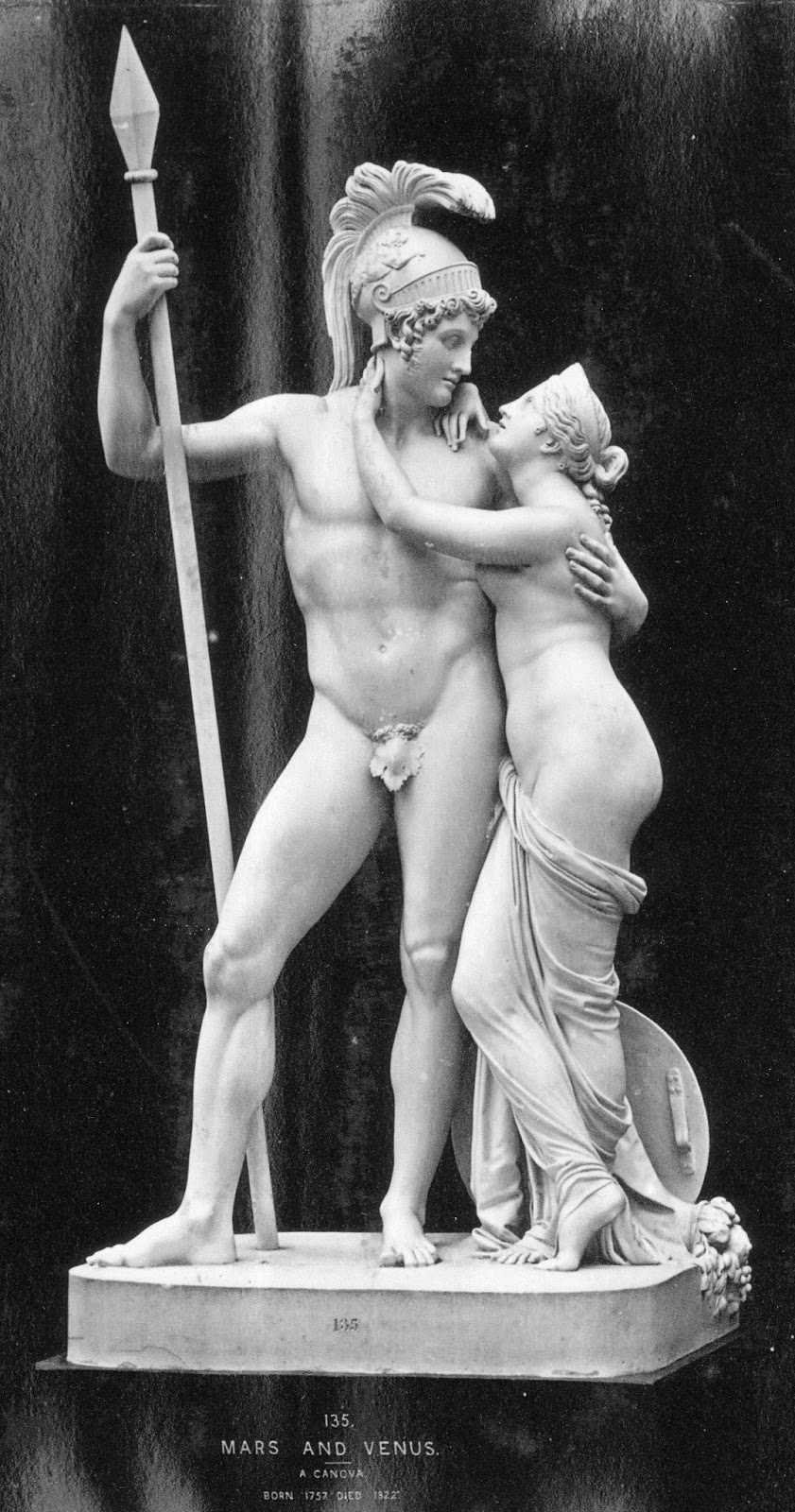
136. DANCING GIRL.
Statue. Life size.
Called in Italian “la Dansatrice ;” she appears in the act of stepping forward lightly and gaily, with her hands at her sides.
The original marble of this well-known statue was executed for the Empress Josephine, and is now in the possession of the Emperor of Russia.
(There is a third Dansatrice better than either of these, who, with the arms raised, and striking the cymbals, appears to be moving to her own music ; this statue is not so well known ; the original, or a duplicate, belongs I think to Lord Londonderry.)
All these three dancers exhibit the same merits and the same faults ; they are executed with consummate delicacy and finish, but remind us too much of ballet dancers.
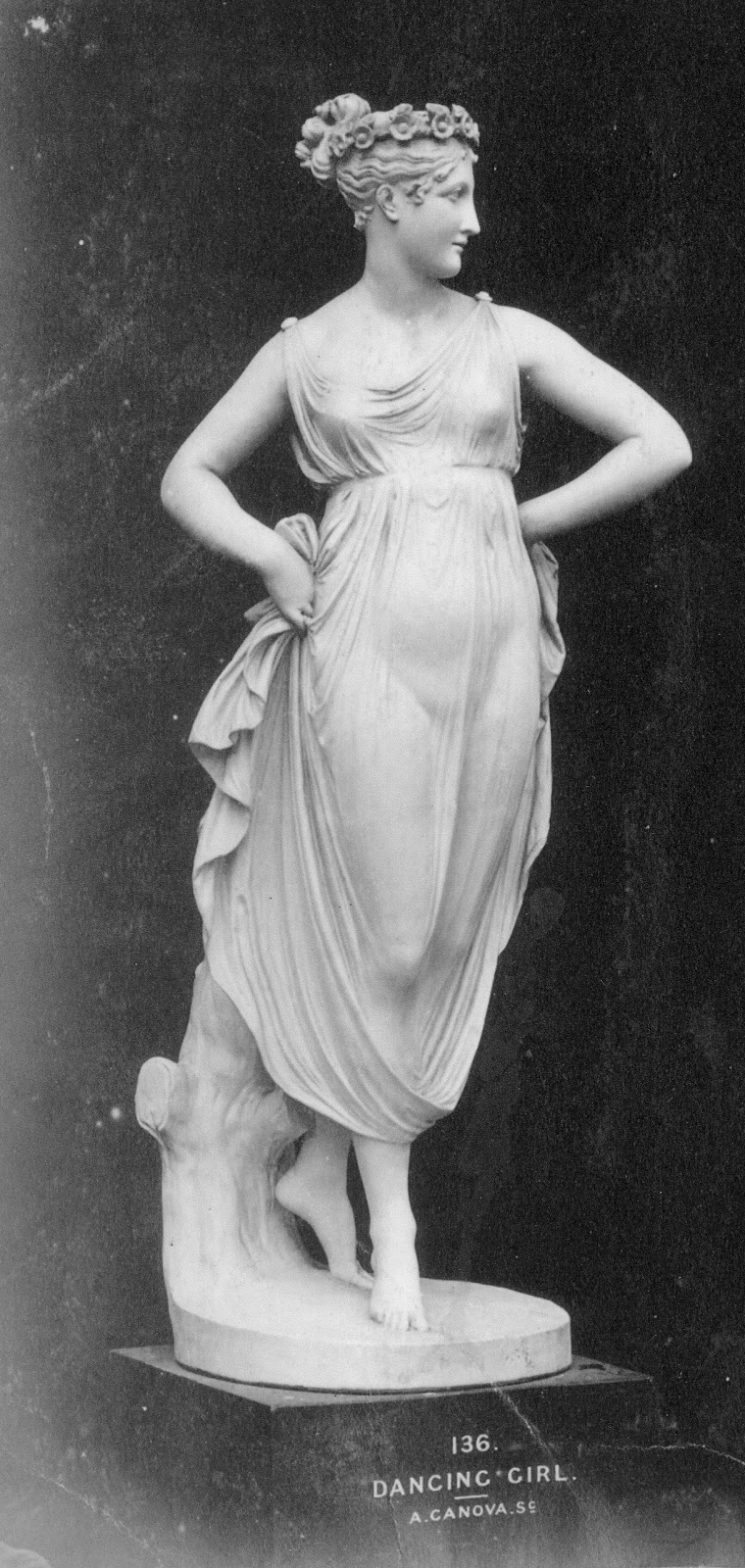
137. DANCING GIRL.
Statue. Life size.
Called “La dansatrice in riposo” – the dancer in rpose. She leans against a pedestal, with one finger on her lip, and a wreath hanging on her left arm ; the original marble was executed for Signor Domenico Manzoni of Forli. There are many repetitions and copies.
[1809-1814. 173 x 60 x 45 cm]
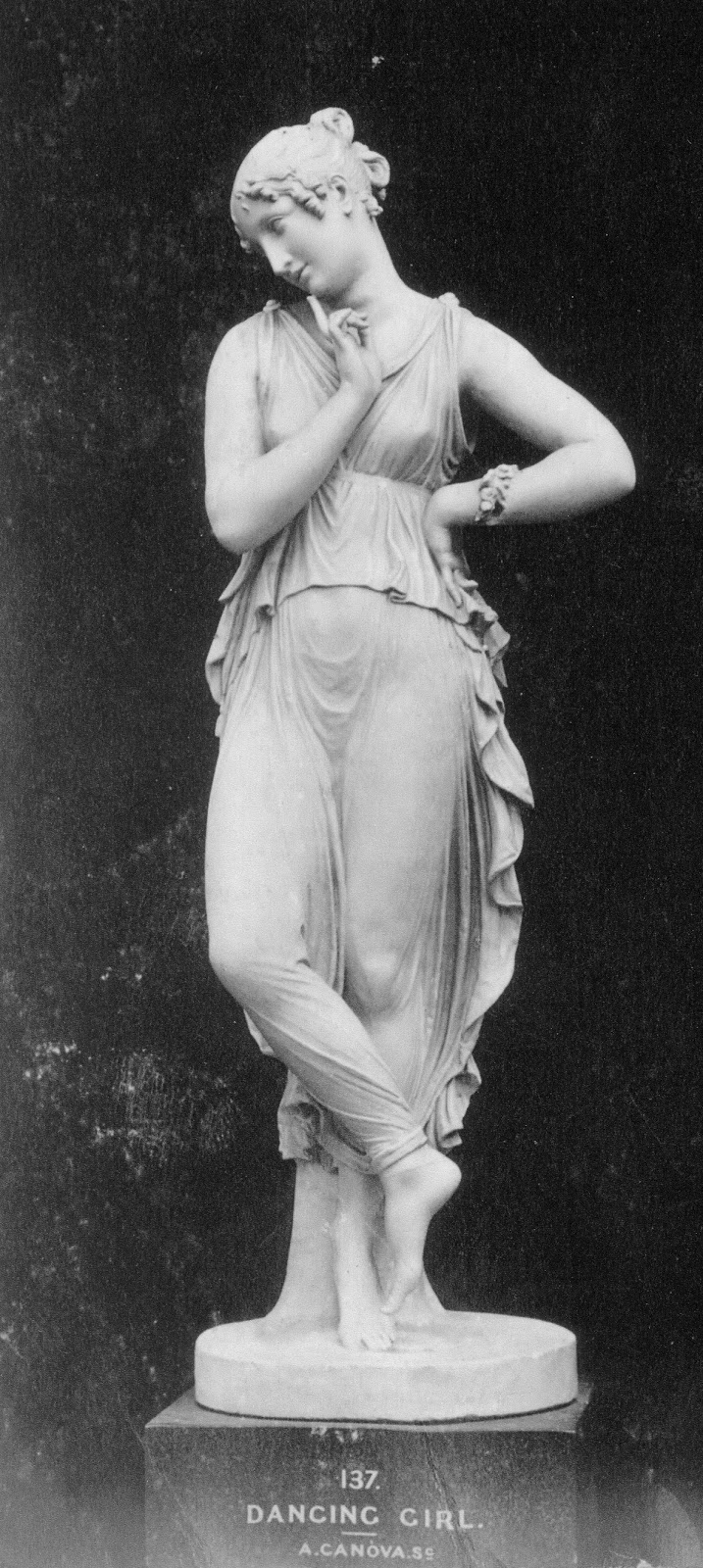
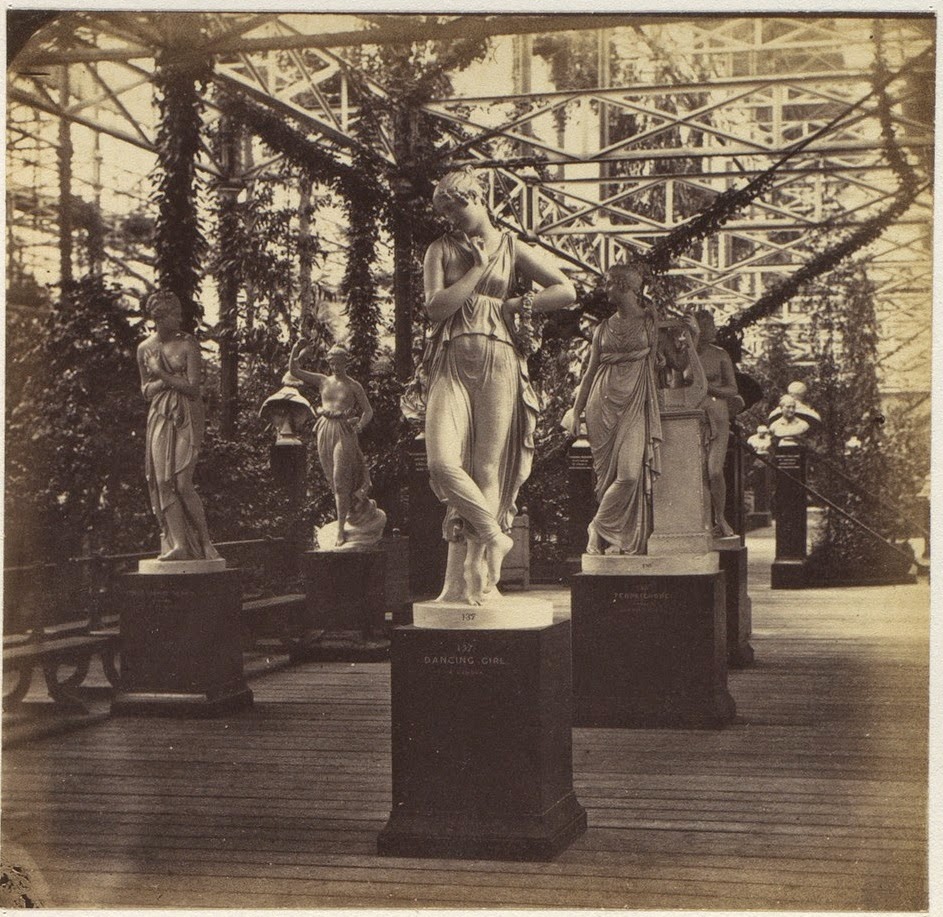
138. THE MAGDALENE.
Statue. Life size.
A female figure, almost entirely undraped, in a half-kneeling, half-contemplative attitude, holds a cross in her extended hands, and appears to condsider it with profound sorrow and repentance. The original conception, one of the most admired and well-known of Canova’s works, and a favourite with himself, was first modelled in 1796. It was executed in marble in 1809, and became the property of Count Somariva ; repetitions were executed for Prince Eugene and others. The fault of this statue is the want of ideal individuality ; it represents a penitent woman ; the sinner oppressed with the sense of sin, rather than the redeemed saint ; not therefore the proper character of Mary Magdalene : but the pathetic beauty of the conception had rendered it deservedly popular.
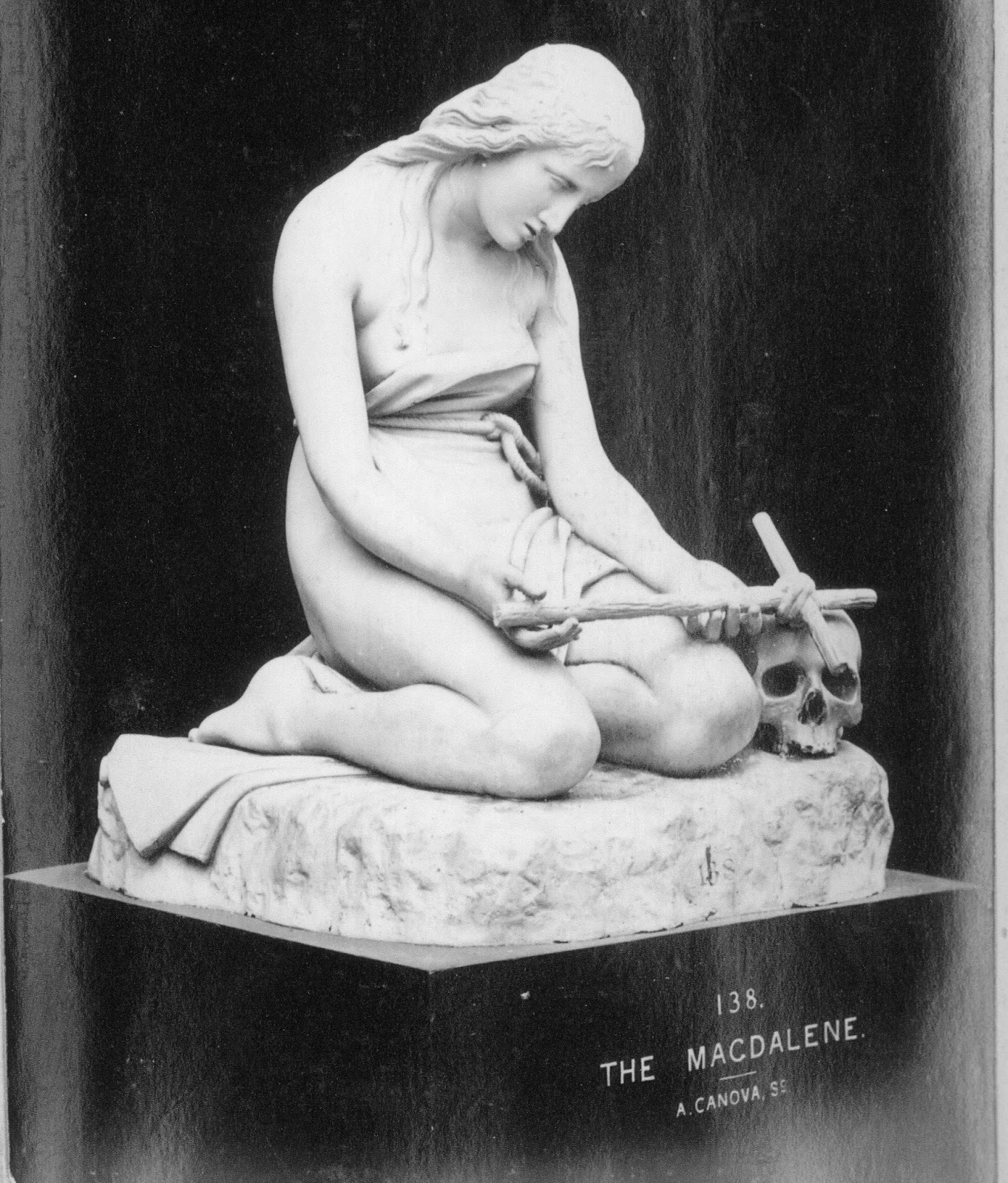
139. PERSEUS.
Statue. Heroic size.
Perseus, as conqueror of the Gorgon medusa, whose head he holds up in triumph. The original marble is now in the Vatican of Rome. When the Apollo Belvedere was carried off to Paris, the Perseus was placed upon its pedestal, and was beheld with unbounded enthusiasm and admiration. It is however, one of the least successful of Canova’s works, a mannered imitation of the Apollo, without character, and without individuality ; the same qualities which rendered the statues of Paris and Adonis masterpieces, are out of place in the conception of the heroic Perseus.
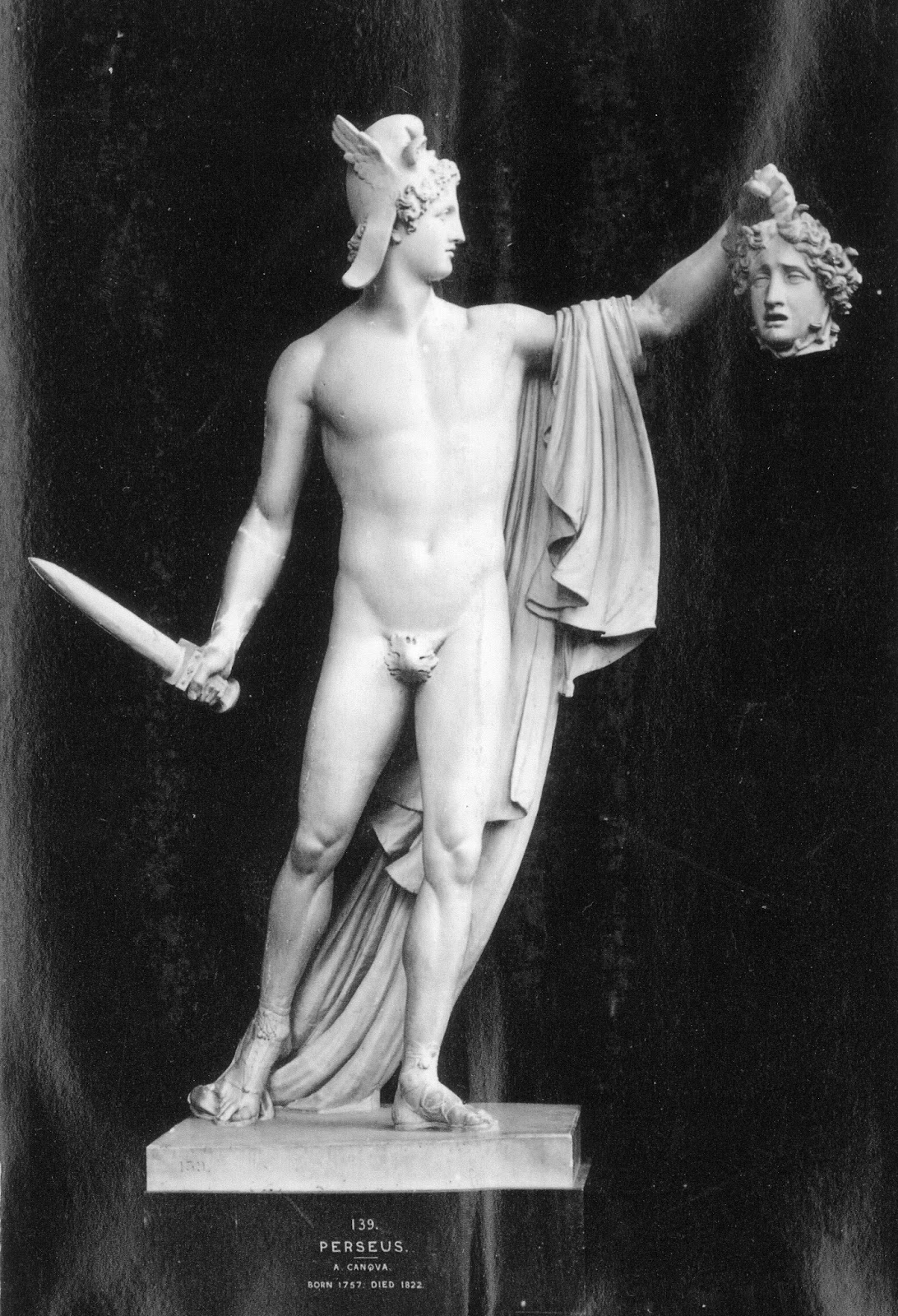
140. PERSEUS.
Head of the above statue.
 http://wwwdelivery.superstock.com/WI/22 ... -27227.jpg
http://wwwdelivery.superstock.com/WI/22 ... -27227.jpg
141. A FUNEREAL VASE.
This vase (on which is a portrait) was dedicated to the memory of an Italian countess, and is, I think, in a church at Padua. It is not in a high taste.
141*. POPE CLEMENT XIII. (CARLO REZZINICO)
(Carlo Rezzinico)
The head of the grand colossal statue in St. Peter’s at Rome. Excedingly fine, both as a portrait and a work of art. (See Portrait Gallery, No. 194.)

141+. A SLEEPING LION.
One of the two lions on the tomb of the same Pope. The lion is justly considered one of the grandest things which Canova ever produced.

